The Public Library Narrative Essay
Introduction, the services provided by the public library, the cooperation with political and governmental structures, reference list.
Rapid development of information technologies, especially Internet and various social changes contributed to the decline of public library usage in the United States and many other countries (Goulding 2006, p. 112). This trend urges these organizations to improve their practices and find new ways of attracting visitors.
This paper is aimed at describing an imaginary public library that will serve the needs of a middle-sized city with a population of 150,000 people. In particular, it is necessary to identify the major services that it will provide. Secondly, this essay will explain how this institution will cooperate with other public libraries and governmental structures. Thirdly, one has to explain the principles that will govern this organization.
One should note that this organization will operate in the environment which does not yet exist. This means that this institution will not have to face budgetary constraints as it is often done by public libraries. Secondly, it will work in the environment in which the government fully appreciates the educational importance of such organizations and supports them.
First, we should say that this organization will be a part of a large library system. The thing is that such networking enables libraries to better share resources and information (Wilson 1992, p. 166). It is particularly important when we speak about books or periodicals.
Secondly, these institutions will able to share information about user’s most common requests. As it has been said before, this organization will work in a middle-sized city. Its population will have various educational, informational, and developmental needs and this library will serve these needs.
At this point, it is necessary to speak about these functions in more detail. First of all, this public library will support those people who pursue their education. In this case, one can mention school, college, or university students and those people who want to acquire new knowledge in their professional area (McClure & Jaeger 2009, p. 50).
The readers of this library will represent various age groups. They will be able to find literature related to their areas of study. Admittedly, this organization cannot be compared to a research library in which a collection is focused on one or two specific subjects. The books and articles stored in this public library will be related to a variety of scientific disciplines or liberal arts.
Another type of services will be related to the informational needs of the clients. These needs can very heterogeneous, and it is rather difficult to identify each of them. The readers must be provided access to a variety of printed and online sources of information. The staff of this library will also help clients develop their information literary skills.
In other words, these visitors must know how to access and evaluate various sources of information and assess their validity (Roman& Fiore 2010, p. 27). This issue is particularly important for children and adolescents. On the whole, these skills are indispensible for a modern person who has to cope with information overload. Thus, the employees of this public library must show not only where one can find information but also how it can be done.
Thirdly, this library will facilitate personal development of the readers. The visitors will be provided with access to various “works of imagination” which can include the best examples of the world literature and sometimes even cinematography or music (Dewe 2006, p. 18).
This is the practice adopted in many public libraries. In addition to that, this library will attempt to increase people’s awareness about health, law, environment, society, and so forth (Dewe 2006, p. 18). In this case, the developmental needs of an individual can be linked to the social problems faced by the community. So, these are some of the services that this library will offer to the clients.
There are several distinctive features of this organization that are worth discussing. For example, this library will have a multi-media collection. The clients will be able to request various printed sources, E-books, disks, or audiobooks. The use of multimedia can be of great importance to those people with disabilities, for example, with visual impairments (Barker 2011, p. 9).
This public library will attempt to provide opportunities for people, whose problems prevent them from reading printed sources of information. For example, it might be necessary to install screen readers on computers in order to help some of the visitors. This organization will try to pursue the policies of social inclusion, rather than exclusion.
The second aspect is that this functioning of this public library will be based on proper utilization of information technologies. For instance, this library will have a digitized catalog that will help the clients search for books or periodicals. Furthermore, the visitors will also be able to use various online databases. The information technologies will greatly improve the storage and retrieval of information (Carnegie & Abell 2009). They will be essential for the effective functioning of this organization.
Another important peculiarity is the emphasis on self-service (Downes, 2010). The patrons of this library will not have to ask the permission of the librarian when they need to use Internet or when they have to check out books. On the whole, one can single out several things which are indispensible for the effective functioning of this organization, namely, multimedia sources, increased use of information technologies, and simplified procedures.
There are several rational for adopting these strategies. First, public libraries have to focus on the needs of the visitors rather than bureaucratic rules (Mathews 2009, p. 8).
Moreover, these organizations have to keep a close track of technological changes. Moreover, they must try to include every member of the community. This is why it is necessary to adopt the technologies which can help people with disabilities. However, this public library can have these resources only if the local authorities and government in general are willing to support them.
This organization will not be isolated from governmental or political structures. Unfortunately, it is rather difficult to create a public library that will be financially independent of the local or federal government. Therefore, to some extent, this institution will be accountable to governmental institutions, for example, the board of directors who represent the city council. As a rule, public libraries have to report and justify their expenses or explain the reasons for structural changes if they do occur (Koontz & Gubbin 2010, p. 24).
This governing body will be responsible for decisions related to the general strategy rather than daily operations, rather than daily operations. The main issue is that those people, who are on the board of directors, must be proficient in librarianship and the management of non-profit organization (Koontz & Gubbin 2010, p. 24).
If they do not have these skills, it is quite likely that the chief librarian and the directors will have significant disagreements. Hopefully, the administrators of this library will be more or less autonomous from political or governmental structures. This autonomy is indispensible for the effective management of this organization.
The second issue, which is also very important, is the political structure of the public library. It seems to me that such organizations must be able to distance themselves from politics.
Certainly, they should promote liberal or democratic values; however, they should not be strongly affected by the world of politics. Apart from that, this public library will be accountable to the community, in general. The management of this organization must explain how they can improve the experiences of the visitors and what efforts are made in order to achieve this goal.
Overall, the public library described in this paper can come into existence on condition that the federal and local governments decide to pay more attention to the needs of such institutions, especially when one is speaking about the funding of these organizations. This essay has described the key features that the public library should have.
Among them one can single out the adoption of multimedia, increased usage of information technologies, and simplified procedures. Although, this organization will be accountable to local government, its administrators will have a high degree of autonomy. Hopefully, the idea of such hypothetical library can be implemented in a real-life environment.
Barker, D. (2011). On The Outside Looking In: Public Libraries Serving Young People With Disabilities. Aplis, 24 (1), 9-16.
Carnegie, T. M., & Abell, J. (2009). Information, Architecture, and Hybridity: The Changing Discourse of the Public Library. Technical Communication Quarterly, 18 (3), 242-258.
Dewe, M. (2006). Planning public library buildings: concepts and issues for the librarian. London: Ashgate Publishing, Ltd.
Downes, A. (2010). Putting readers first: frontline training in Victoria. Aplis, 23 (4), 132-140.
Goulding, A. (2006). Public libraries in the 21st century: defining services and debating the future. NY: Ashgate Publishing, Ltd.
Koontz, C. & Gubbin, B. (2010). IFLA public library service guidelines . London: Walter de Gruyter.
Matthews, J. (2009). The Customer-Focused Library: Re-Inventing the Library from the Outside-In . NY: ABC-CLIO.
McClure, C. & Jaeger, P. (2009). Public libraries and Internet service roles: measuring and maximizing Internet services . Washington: ALA Editions.
Roman, S., & Fiore, C. D. (2010). Do Public Library Summer Reading Programs Close the Achievement Gap? Children & Libraries: The Journal Of The Association For Library Service To Children, 8 (3), 27-31.
Wilson, T. (1992). Impact of technology on resource sharing: experimentation and maturity . NY: Routledge.
- Chicago (A-D)
- Chicago (N-B)
IvyPanda. (2019, July 10). The Public Library. https://ivypanda.com/essays/the-public-library/
"The Public Library." IvyPanda , 10 July 2019, ivypanda.com/essays/the-public-library/.
IvyPanda . (2019) 'The Public Library'. 10 July.
IvyPanda . 2019. "The Public Library." July 10, 2019. https://ivypanda.com/essays/the-public-library/.
1. IvyPanda . "The Public Library." July 10, 2019. https://ivypanda.com/essays/the-public-library/.
Bibliography
IvyPanda . "The Public Library." July 10, 2019. https://ivypanda.com/essays/the-public-library/.
- Library Descriptions and Challenges
- Library and Information Science
- Multimedia Learning During Art and Design Lessons
- Job Evaluation, Market Pricing & Pay Structures
- Ministry of Sound Strategic Management
- Transformational, Self-Leadership, Kyosei and Customer Relationship Leadership Styles
- The Project of Setting Up and Constructing Aloe Wood Workshop
- Innovation and Creativity Cannot Be Developed in an Organization

Essay on Library and Its Uses for Students and Children
500 words essay on library and its uses.
A library is a place where books and sources of information are stored. They make it easier for people to get access to them for various purposes. Libraries are very helpful and economical too. They include books, magazines, newspapers, DVDs, manuscripts and more. In other words, they are an all-encompassing source of information.

A public library is open to everyone for fulfilling the need for information. They are run by the government, schools , colleges, and universities. The members of the society or community can visit these libraries to enhance their knowledge and complete their research.
Importance of Libraries
Libraries play a vital role in providing people with reliable content. They encourage and promote the process of learning and grasping knowledge. The book worms can get loads of books to read from and enhance their knowledge. Moreover, the variety is so wide-ranging that one mostly gets what they are looking for.
Furthermore, they help the people to get their hands on great educational material which they might not find otherwise in the market. When we read more, our social skills and academic performance improves.
Most importantly, libraries are a great platform for making progress. When we get homework in class, the libraries help us with the reference material. This, in turn, progresses our learning capabilities and knowledge. It is also helpful in our overall development.
Get the huge list of more than 500 Essay Topics and Ideas
Uses of Library
A library is a very useful platform that brings together people willing to learn. It helps us in learning and expanding our knowledge. We develop our reading habits from a library and satisfy our thirst and curiosity for knowledge. This helps in the personal growth of a person and development.
Similarly, libraries provide authentic and reliable sources of information for researchers. They are able to complete their papers and carry out their studies using the material present in a library. Furthermore, libraries are a great place for studying alone or even in groups, without any disturbance.
Moreover, libraries also help in increasing our concentration levels. As it is a place that requires pin drop silence, a person can study or read in silence. It makes us focus on our studies more efficiently. Libraries also broaden our thinking and make us more open to modern thinking.
Most importantly, libraries are very economical. The people who cannot afford to buy new books and can simply borrow books from a library. This helps them in saving a lot of money and getting information for free.
In short, libraries are a great place to gain knowledge. They serve each person differently. They are a great source of learning and promoting the progress of knowledge. One can enjoy their free time in libraries by reading and researching. As the world has become digitized, it is now easier to browse through a library and get what you are looking for. Libraries also provide employment opportunities to people with fair pay and incredible working conditions.
Thus, libraries help all, the ones visiting it and the ones employed there. We must not give up on libraries due to the digital age. Nothing can ever replace the authenticity and reliability one gets from a library.
FAQs on Library and Its Uses
Q.1 Why are libraries important?
A.1 Libraries help in the overall development of a person. They provide us with educational material and help enhance our knowledge.
Q.2 State some uses of the library.
A.2 A library is a great platform which helps us in various things. We get the reference material for our homework. Research scholars get reliable content for their papers. They increase our concentration levels as we read there in peace.
Customize your course in 30 seconds
Which class are you in.

- Travelling Essay
- Picnic Essay
- Our Country Essay
- My Parents Essay
- Essay on Favourite Personality
- Essay on Memorable Day of My Life
- Essay on Knowledge is Power
- Essay on Gurpurab
- Essay on My Favourite Season
- Essay on Types of Sports
Leave a Reply Cancel reply
Your email address will not be published. Required fields are marked *
Download the App

- Divisions and Offices
- Grants Search
- Manage Your Award
- NEH's Application Review Process
- Professional Development
- Grantee Communications Toolkit
- NEH Virtual Grant Workshops
- Awards & Honors
- American Tapestry
- Humanities Magazine
- NEH Resources for Native Communities
- Search Our Work
- Office of Communications
- Office of Congressional Affairs
- Office of Data and Evaluation
- Budget / Performance
- Contact NEH
- Equal Employment Opportunity
- Human Resources
- Information Quality
- National Council on the Humanities
- Office of the Inspector General
- Privacy Program
- State and Jurisdictional Humanities Councils
- Office of the Chair
- NEH-DOI Federal Indian Boarding School Initiative Partnership
- NEH Equity Action Plan
- GovDelivery
The Complicated Role of the Modern Public Library
Something for everyone.
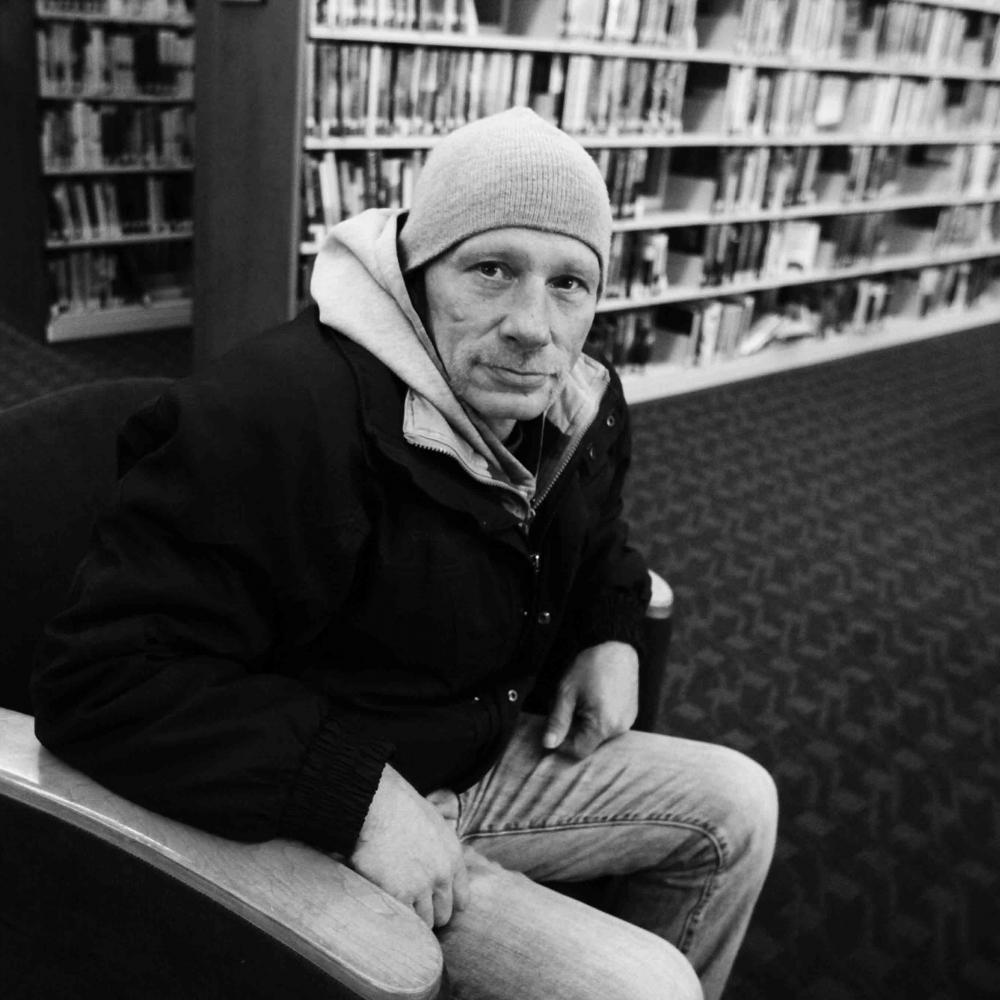
A homeless patron, Allen Barkovich, sits in the Woodmere Branch of the Traverse Area District Library in Michigan, 2013.
—AP Photo / Traverse City Record-Eagle , Keith King
There aren’t many truly public places left in America. Most of our shared spaces require money or a certain social status to access. Malls exist to sell people things. Museums discourage loiterers. Coffee shops expect patrons to purchase a drink or snack if they want to enjoy the premises.
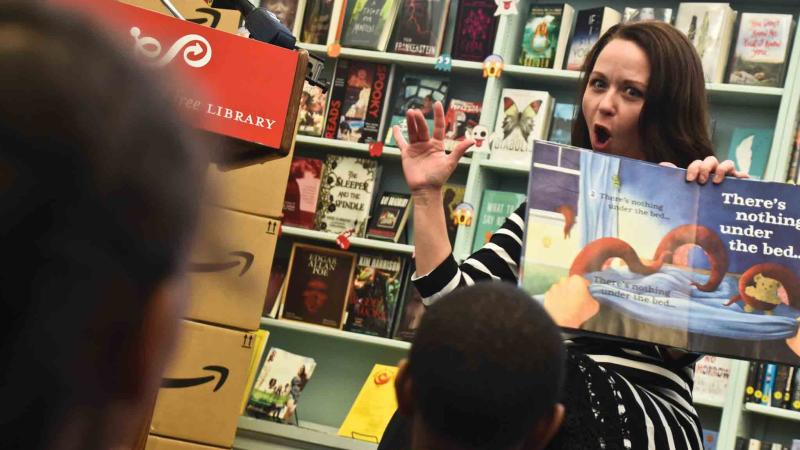
Pratt Library President and CEO Heidi Daniel reads at story time.
—Enoch Pratt Free Library
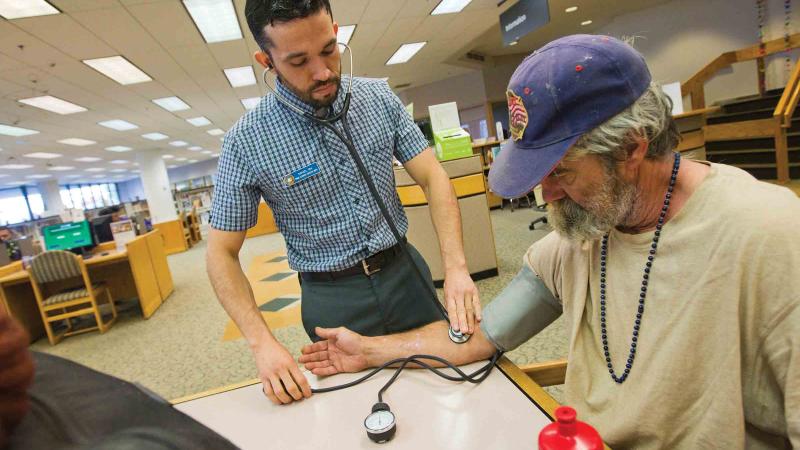
Pima County Health Department Library Nurse Daniel Lopez takes the blood pressure of homeless man Jim Truitt at the Main Joel D. Valdez Pima County Public Library in Tucson, Arizona.
—© Pima County Public Library
One place, though, remains open to everybody. The public library requires nothing of its visitors: no purchases, no membership fees, no dress code. You can stay all day, and you don’t have to buy anything. You don’t need money or a library card to access a multitude of on-site resources that includes books, e-books and magazines, job-hunting assistance, computer stations, free Wi-Fi, and much more. And the library will never share or sell your personal data.
In a country riven by racial, ethnic, political, and socioeconomic divides, libraries still welcome everyone. “We are open spaces,” says Susan Benton, the president and CEO of the Urban Libraries Council, whose members include public-library systems serving cities large and small across the United States. “We certainly are without judgment about anybody’s characteristics.”
That commitment to inclusivity, along with a persistent ability to adapt to changing times, has kept public libraries vital in an era of divisive politics and disruptive technological change. But it has also put pressure on them to be all things to all people, and to meet a vast range of social needs without correspondingly vast budgets. These days, a branch librarian might run story hour in the morning, assist with a research project at lunchtime, and in the afternoon administer life-saving medical aid to a patron who’s overdosed on the premises.
If the idea of libraries as frontline responders in the opioid crisis sounds far-fetched, look no further than the Denver Public Library. In February 2017, a twenty-five-year-old man suffered a fatal overdose in one of its bathrooms. That prompted the library to lay in a supply of Narcan, a drug used to counteract opioid overdoses. Other libraries, including the San Francisco Public Library, have followed suit and begun to stock the life-saving drug.
Such interventions indicate the expanded role our public libraries now play in a fraying social network. Eric Klinenberg, a sociologist based at New York University, spent a year doing ethnographic research in New York City library branches for his latest book, Palaces for the People: How Social Infrastructure Can Help Fight Inequality, Polarization, and the Decline of Civic Life . Klinenberg borrowed the title from Andrew Carnegie, the Gilded Age industrialist-turned-philanthropist who funded some three thousand public libraries—“palaces for the people”—in the United States and abroad.
In an update of Carnegie’s idea, Klinenberg describes public libraries as “social infrastructure.” That means “the physical spaces and organizations that shape the way people interact,” he wrote in a 2018 op-ed in the New York Times . “Libraries don’t just provide free access to books and other cultural materials, they also offer things like companionship for older adults, de facto childcare for busy parents, language instruction for immigrants and welcoming public spaces for the poor, the homeless and young people.”
Klinenberg’s book is just one of a series of recent high-profile tributes to America’s public libraries. The New Yorker writer Susan Orlean’s most recent book, called simply The Library Book , begins with a personal love song to the subject before diving into the rich, troubled history of the Los Angeles Public Library and its iconic building in downtown L.A. In 2014, the photographer Robert Dawson published a book-length photographic essay that lovingly documents the astonishing variety of the seventeen thousand or so public libraries across the United States, from one-room shacks in the tiniest of towns to branches in strip malls to breathtaking, Carnegie-era book palaces in center cities. And a forthcoming NEH-funded documentary, Free for All: Inside the Public Library , brings to life some of the history and personalities that have shaped this major force for public good.
All of these projects confirm how libraries have proved over and over again, through decades of rapid change and predictions of obsolescence, that they remain essential to Americans’ lives. In an era of extreme weather events and other disasters, they’re becoming even more necessary.
The journalist Deborah Fallows and her husband, James Fallows, road-tripped across the country to report their 2018 book Our Towns: A 100,000-Mile Journey into the Heart of America , in which public libraries play a starring role. “In Ferguson, Missouri, the public library stayed open when the schools were closed after the riots, to offer the kids a safe place and even classes taught by volunteers,” Deborah Fallows wrote in a May 2019 dispatch for the Atlantic . “After the hurricanes in Houston, some library websites were immediately up and running, announcing that they were open for business. After Hurricane Sandy, some libraries in New Jersey became places of refuge. And in the Queens Library’s Far Rockaway branch, which didn’t have heat or light, the librarians set up shop in the parking lot to continue children’s story hours.”
Beyond Books
There are limits to the civic responsibilities public libraries can shoulder. “We’re not the police, we’re not social workers,” says Monique le Conge Ziesenhenne, the director of the Palo Alto City Library system in Silicon Valley and the 2018–19 president of the Public Library Association, a division of the American Library Association. “We do provide an important thread to a community’s well-being and health.”
In calmer times, public library systems offer a staggering array of programming that goes well beyond the books-and-story-time model many of us remember from our childhoods.
Ziesenhenne rattles off a list of some of Palo Alto’s offerings: a seed-lending library, home-brewing tutorials, a “Knack 4 Knitting” club, bilingual story hours, programs designed to help immigrants learn how to live in the United States. Keeping up with a national trend, the library recently created a makerspace with 3-D printers. In July, one branch hosted a workshop on how to use “graywater” from inside a house to sustain native-plant landscaping in the yard.
The list goes on and on. There’s something for almost everyone at the local library, whether you’re a parent who needs literacy support for your preschooler, an immigrant working on language skills or bureaucratic forms, a mystery fan in search of the latest whodunit by a favorite author, or someone experiencing homelessness who needs assistance with social services or access to a computer and the Internet.
Or you could just check out a book, as generations of library patrons have done before you. As extra-literary programs and digital offerings have expanded, the codex has not faded away. “We are still crazy busy with the basic printed materials,” Ziesenhenne says. “In Silicon Valley you would not necessarily expect that, but it’s absolutely true.”
Being located at the wealthy epicenter of the tech revolution doesn’t mean that the library has bottomless funds, though. Like most libraries, “we never have enough money for what we want to do,” Ziesenhenne says.
Even as print thrives, public librarians everywhere spend a lot of time wrangling with the great digital shift and how to adapt to it. In Palo Alto and elsewhere, they’re seeing an increase in the use of digital content as patrons become more familiar with how to use streaming media.
To keep up with changing technology and user expectations, public libraries have invested in more computer terminals and Wi-Fi capability. They have upgraded and expanded facilities to provide more outlets, meeting rooms, study spaces, and seating that patrons can use for extended periods of time as they take advantage of free Wi-Fi.
New, bigger, brighter coworking spaces see high usage among millennials, according to Ziesenhenne. “We are the original sharing economy, I like to say.”
The explosion of information online hasn’t sidelined librarians. It’s only made them more essential at a time when too few of us know how to distinguish real news from the fake variety. “We’ve worked very hard to think about media and how information is presented and ways we can equip people going forward to look for clues on a website,” including asking how old the content is and who’s providing it, Ziesenhenne says.
Librarians have an advantage in making themselves heard through the noise and confusion: Along with nurses and firefighters, they’re among the few groups and institutions Americans still trust, according to Lee Rainie, director of Internet and technology research at the Pew Research Center.
From 2011 until 2016, Pew did a number of deep-dive studies of public libraries, work funded by the Bill & Melinda Gates Foundation. In those surveys, researchers found that trust in librarians remained high because of their proven ability to curate and share reliable knowledge. “That’s become one of the more precious skills in a world where gaming the information ecosystem is an everyday reality,” Rainie says.
Pew’s library research generated other findings that grabbed media attention: Millennials grew up loving libraries and continue to support and make use of them, Rainie says. Now that they have families of their own, they’ve remained loyal. Having a child under the age of six is the biggest predictor of library use, Rainie adds; parents of young children like the family-friendly programs libraries run.
Pew’s research also found that families often see libraries as sanctuaries. “They were zones of peace, sometimes, in neighborhoods and communities where that was a precious commodity,” notes Rainie.
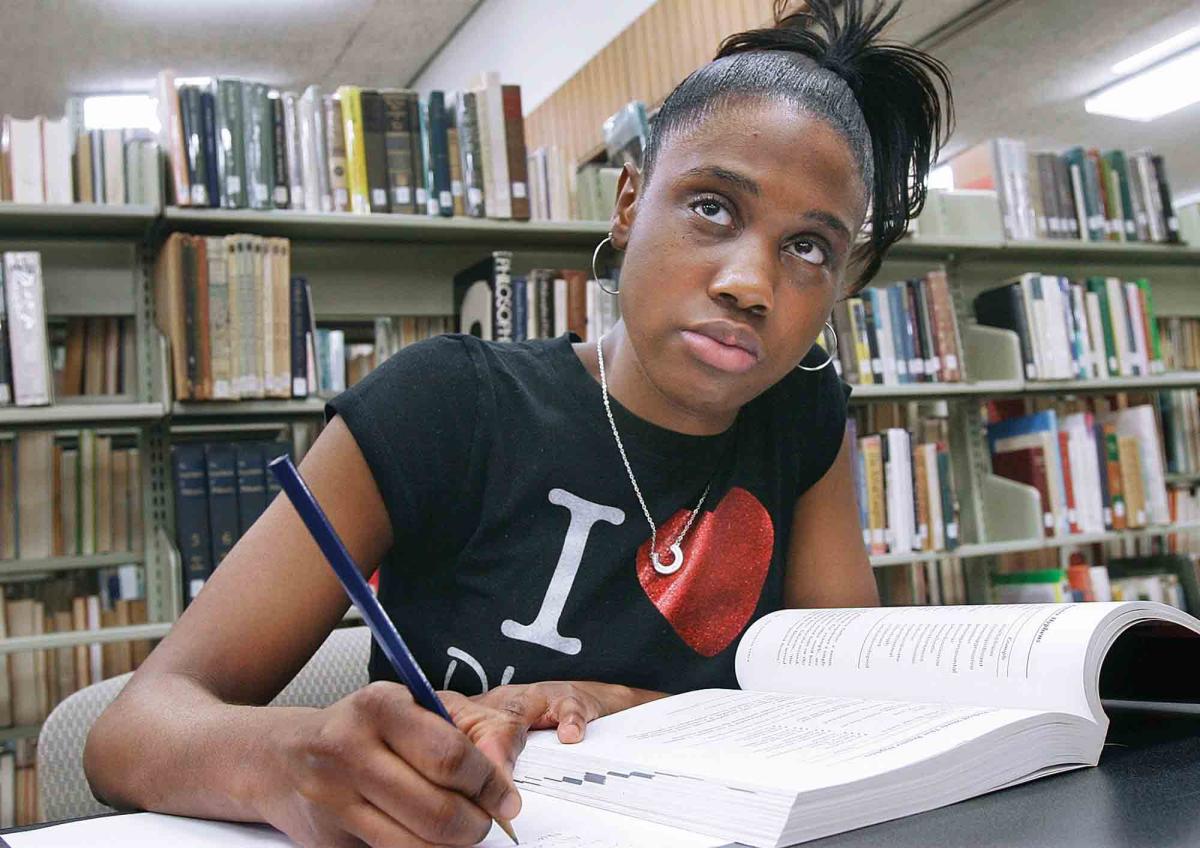
Formerly homeless high school student, Tinesheia Howard studies at the library of Lincoln College in Lincoln, Illinois.
—AP Photo / Seth Perlman, 2008
For many teens and adults, especially those from underprivileged backgrounds or without computer access at home, the local branch also functions as an on-ramp to the Internet. “Libraries have rebranded themselves as tech hubs without a lot of fanfare,” he says. They allow customers to learn and experiment with new digital resources such as 3-D printers without having to invest in them at home. “People treat libraries as petting zoos for new technology,” as Rainie puts it.
All of those activities require staff time and/or money. As they decide where to spend finite resources, libraries rely on survey data and on detailed conversations with their communities to keep content and programming up to date and adjust what they offer as times and needs change. Library staffers often act as community liaisons even when they’re not on duty, bringing back grassroots knowledge that helps the library add or adapt services in response.
“The library of my youth made all the rules,” says Patrick Losinski, CEO of the Columbus Metropolitan Library in Ohio. The mantra of today’s library, he says, is: How do you meet people where they want to be?
To get answers, the Columbus library recently hired a survey firm to gather information on patrons’ use of and views on the library. The results revealed a virtual town square of activity, with visitors dropping by to check out and return books (41 percent), bring their kids to play area (13 percent), do research (14 percent), read and relax (13 percent), study (9 percent), and use Wi-Fi, computers, printers, or copiers (about 27 percent combined). “Our customers also checked out more than fifteen million items last year, so we’re still a library,” Losinski says.
The survey confirmed that the community views its library as a force for social good. Ninety-one percent of respondents said helping kids by working more closely with schools should be one of the library’s top priorities; 50 percent said that should be its highest priority. Losinski reports that over 50 percent of the area’s youngsters do not have the literacy skill set they need for kindergarten, including basics such as how to hold a book and how to pronounce words they encounter.
Being able to read well gives kids a leg up in schooling and in life, but many children do not have the resources—books at home, parents with time and literacy skills and good child care—to help them master that skill. Public libraries around the country are stepping up to the challenge.
Children participate in 37,000 sessions a year in the Columbus library’s reading-buddies program, which helps kids prepare for a reading-proficiency test in third grade. In Los Angeles County, libraries have recast traditional story time as “school readiness time” and rebranded bookmobiles as “Reading Machines” to visit day care centers and bring parenting-support strategies out into the community.
“Libraries are not about books, they’re about people,” says Skye Patrick, who since 2016 has been the director of the Los Angeles County Library system. When Library Journal named Patrick its Librarian of the Year for 2019, it saluted her “efforts to eliminate barriers and increase access to services for her residents.”
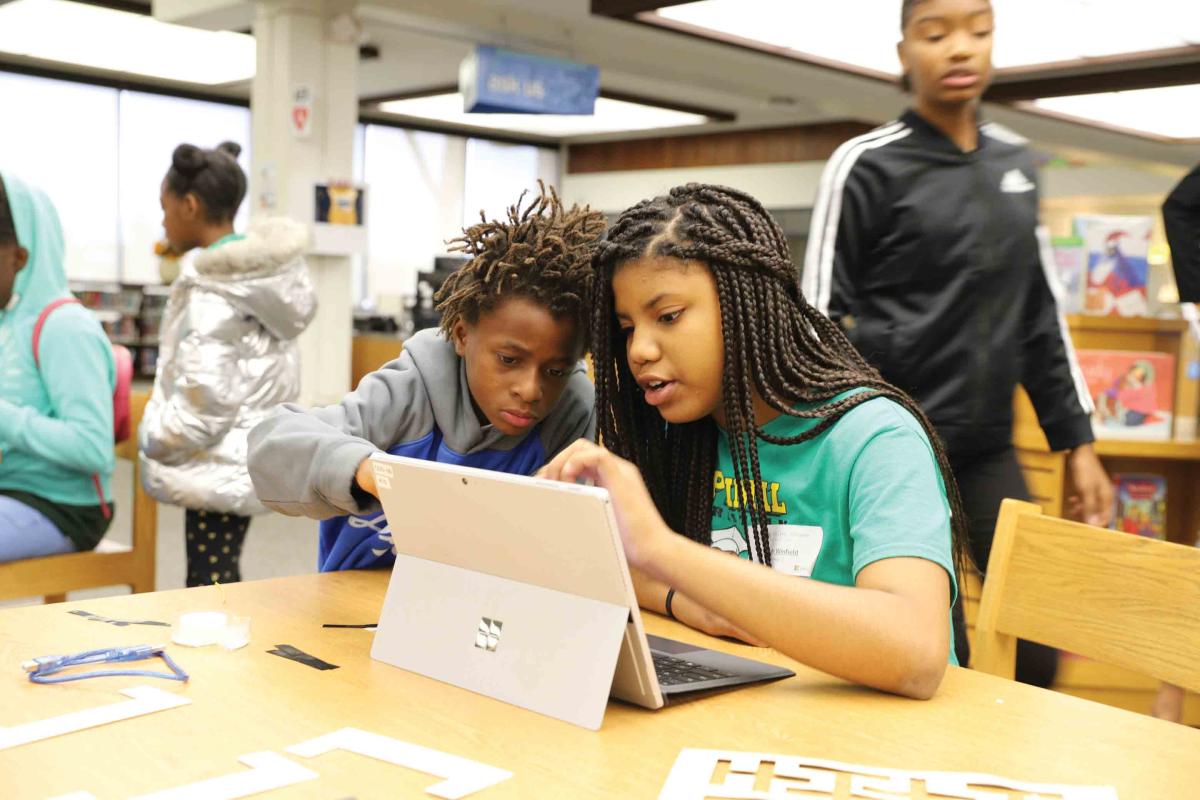
Compton Library holds a Microsoft Digi Camp for students in 2018.
—Los Angeles County Library System
“Equity means different things for different people,” Patrick says. “We wanted to challenge our staff to have a better awareness both of the experience of their colleagues and the experience of their customers.”
Patrick’s strategy to improve library access included putting in place a program called iCount, which provides tools and training for supervisors and staff on how to recognize inherent biases in programs and services. Thinking hard about equity and a wide range of patron experiences and needs is a must for L.A. County’s librarians, who work in one of the four largest and most diverse public library systems in North America. (The other three are the Toronto Public Library, the New York Public Library, and the Los Angeles Public Library system that serves the city of L.A.) The county has 86 library facilities (plus three bookmobiles) that collectively serve about 3.4 million residents; the system covers some 3,000 square miles and 49 cities.
Statistics for the fiscal year that ended June 30, 2018, give a sense of the scale at which it operates: annual circulation—10,857,015; e-book circulation—1,184,289; reference and information questions handled—5,908,474; number of Wi-Fi sessions—4,388,244.
Patrick is no stranger to large library systems; she ran the Broward County Library in Florida before she took her current job. In her experience, there is no workable one-system-fits-all model for public libraries. When she arrived in L.A. County, she set up a listening tour to meet with some of the county’s 3.4 million residents to hear what they wanted from their library.
“I called it a community visioning system, because I wanted the community to actively participate in the creation of the library they needed,” she says. One of the biggest takeaways: “a resounding desire for more hours.” Along with money constraints, “that’s always the issue for every library,” she says.
In response, the system added fifteen thousand more public service hours with some creative strategies that included the use of self-checkout technology, staggered staff schedules, and an additional 1 to 4 service hours per branch per week. “It was low-hanging fruit for us, and it garnered some true goodwill from the community,” Patrick says.
Other requests, such as a kindergarten class’s request to install slides and serve ice cream every day, weren’t feasible—“although we did think about it!” Patrick says. But “based on that response, they associated us with fun, and that’s a big win.” The kids didn’t see the library as stuffy and rule-bound.
Beyond being fun, libraries create sanctuaries for patrons who have few safe spaces in their lives. “There’s a tremendous amount of comfort and safety for people experiencing mental health issues,” Patrick says. “When they’re here, they’re not on the street.”
That inclusivity brings challenges. Some are minor, as when patrons wash up in library bathrooms because they’ve been living on the streets without access to personal-hygiene essentials. But if mental illness is at work, a library user may need a lot more than a place to clean up.
The vast majority of library users do not represent a danger to other patrons or staff, but libraries’ openness carries risks. Librarians have been threatened or killed in the course of doing their jobs. In January 2019, while getting ready for a book sale, the director of the Fort Myers Beach library in Florida was targeted and stabbed to death by a homeless man. A month earlier, in December 2018, the supervisor of the North Natomas branch of the Sacramento Public Library was shot to death in her car in the library’s parking lot by a man she had banned from the library for bad behavior. Her widower wrote an op-ed in American Libraries magazine to call attention to the dangers that library workers face. But security measures like metal detectors or monitoring systems don’t align well with libraries’ commitment to maintaining patron privacy and creating truly open spaces.
Pew’s Lee Rainie describes libraries as “early warning systems for broad cultural phenomena.” Those phenomena can be positive, such as the thirst to experiment with new technology and the desire to broaden access to good information and social services. But they can also be negative. Tensions between different social groups can arise when people who otherwise rarely interact rub elbows at the library.
Skye Patrick identifies a fracture point between what she calls “our two customer bases.” Some patrons ask for more security at library branches or express dismay about disruptions created by homelessness. Her job involves trying to educate one group about the rights of the other. The bottom line for all patrons: “As long as they are adhering to our code of customer expectations, they have the right to use the library,” she says.
The L.A. County bureaucracy, of which the library is a part, can help smooth the way for the disenfranchised. For instance, the Department of Social Services will provide an address for homeless patrons to use in order to get a library card. The library also offers fine-free cards for young people under 21, eliminating one common barrier to full access. (The system hasn’t dispensed with fines altogether yet, although like many libraries it is moving away from fines and has held amnesty periods in which patrons can return overdue materials without penalty.)
Librarians have long helped users navigate life challenges like finding a job, studying for an exam, or applying to school. More and more they play a crucial role in connecting patrons in need of social or mental health services with relevant agencies. “Our branch staff has been trained to at least point to the kinds of services that are available,” Patrick says.
Along with a growing number of libraries, it joined forces with the mental health department to bring social workers on-site to work with patrons in need. Beyond such partnerships with other county agencies, the Los Angeles County Library focuses on fostering what Skye Patrick calls “protective factors”: meaningful social connections, positive parent-child interactions, positive cultural identity, literacy support, and school readiness.
“Time will tell, but I feel really confident that it’s working,” Patrick says, adding that library staff also feel safer with that extra support in place. “That does not mean it solves everything.” Even an institution as resourceful, flexible, and resilient as the public library has its limits.
Jennifer Howard is a writer based in Washington, D.C. Her work has appeared in the Washington Post , the Chronicle of Higher Education , the Times Literary Supplement , Bookforum , VQR , and elsewhere.
Funding information
The National Endowment for the Humanities has had long and productive partnerships with libraries of all kinds across the country: public libraries, research libraries, specialized libraries and collections, university libraries, and school libraries. NEH library projects—from infrastructure to outreach—help these vital institutions stay current and inclusive.
In 2018, NEH launched a new program for Infrastructure and Capacity-Building Challenge Grants to support brick-and-mortar library projects as well as other efforts to strengthen the institutional base for the humanities in America. For example, the Hartford Public Library in Michigan received a 2019 NEH grant of $400,000 to construct a new library and community center, making available cultural and educational resources for the southwest area of the state.
Free for All: Inside the Public Library is an upcoming documentary on the history of the public library in America. Video Veracity received $540,000 from NEH to plan and produce the film, which looks at past and current uses of libraries and examines the library’s role in American democracy.
With an NEH grant of $315,000 , the University of California, San Francisco, Library, collaborating with San Francisco Public Library and the Gay, Lesbian, Bisexual, Transgender Historical Society, will digitize 150,000 pages from 49 archival collections related to the early days of the AIDS epidemic in the Bay Area and make them accessible online.
NEH has awarded $1,250,000 to the Digital Public Library of America , an online resource for materials in America’s libraries, archives, and museums. From its launch in 2013, the all-digital library has grown from 2.4 million items in its collection to more than 35 million images, texts, videos, and sounds.
The Newberry Library in Chicago has received 183 grants from NEH since 1970 , totaling $53,698,333 to support collection building, exhibitions, research, workshops and institutes for teachers, and public programming. This year, with a $200,000 NEH grant , the library offers a series of citywide public programs and digital resources exploring the history of the July 1919 Chicago race riots.
Since 1970, the American Library Association has received 66 NEH grants , totaling $32,006,701 for projects ranging from bookshelf programs such as Muslim Journeys to traveling exhibits on topics such as the Dust Bowl and the African-American baseball experience, to reading and discussion series such as the Federal Writers Project and the Columbian Quincentenary. In 2018, ALA received an NEH grant of $397,255 to conduct the Great Stories Club, a nationwide program for at-risk teens on themes of empathy, heroism, and marginalization.
Republication statement
The text of this article is available for unedited republication, free of charge, using the following credit: “Originally published as “Something for Everyone” in the fall 2019 issue of Humanities magazine, a publication of the National Endowment for the Humanities.” Please notify us at @email if you are republishing it or have any questions.
SUBSCRIBE FOR HUMANITIES MAGAZINE PRINT EDITION Browse all issues Sign up for HUMANITIES Magazine newsletter
The Public Library: A Photographic Love Letter to Humanity’s Greatest Sanctuary of Knowledge, Freedom, and Democracy
By maria popova.

As the daughter of a formally trained librarian and an enormous lover of, collaborator with , and supporter of public libraries (you may have noticed I always include a public library link for books I write about; I also re-donate a portion of Brain Pickings donations to the New York Public Library each year) I was instantly enamored with The Public Library: A Photographic Essay ( public library ) by photographer Robert Dawson — at once a love letter and a lament eighteen years in the making, a wistful yet hopeful reminder of just what’s at stake if we let the greatest bastion of public knowledge humanity has ever known slip into the neglected corner of cultural priorities. Alongside Dawson’s beautiful photographs are short reflections on the subject by such celebrated minds as Isaac Asimov , Anne Lamott , and E.B. White . From architectural marvels to humble feats of human ingenuity, from the august reading room of the New York Public Library to the trailer-library at Death Valley National Park, braving the glaring sun at one of the hottest places on earth, from the extraordinary vaulted ceilings of LA’s Children’s Library to the small shack turned into a book memorial in the country’s only one-person town, the remarkable range reveals our elemental need for libraries — as sanctuaries of learning, as epicenters of community, as living records of civic identity, and above all as a timelier-than-ever testament that information and human knowledge belong to everybody; not to corporate monopolies or government agencies or ideological despots, but to the people.

In the foreword, the great Bill Moyers — who has long championed the power of reading and self-initiated education — echoes Ray Bradbury’s assertion that libraries are essential for democracy and writes:
The library is being reinvented in response to the explosion of information and knowledge, promiscuous budget cuts in the name of austerity, new technology, and changing needs. Who knows where the emerging new commons will take us? But Robert Dawson shows us in this collection what is at stake: when a library is open, no matter its size or shape, democracy is open, too.

Some years ago, I came across a wonderful effort by a librarian in the small city of Troy in Michigan, which had just opened its first public library. To get the children in the community excited about books and reading, Marguerite Hart reached out to some of the era’s most celebrated minds — writers, actors, senators — and asked them to write letters to the children of Troy, extolling the value of libraries and the joy of books. To her surprise, she got an astounding 91 responses. I spotlighted those letters — including ones from Dr. Seuss, Isaac Asimov, Neil Armstrong, and E.B. White — a few years ago and was delighted to see some of them included in Dawson’s book. Curiously, however, there appears to be a factual error: Dawson lists the city as Troy, New York, whereas in fact it was Troy, Michigan.
But no matter the human error, the heartening humanity of the letters speaks for itself:

One of the most beautiful reflections comes from the inimitable Anne Lamott , who celebrates her 60th birthday on April 10. Her poignant essay “Steinbeck Country” chronicles how Lamott and some friends — writers and artists from all over the West Coast — banded together to save the libraries at Salinas, one of California’s poorest communities, after the government had threatened to close them. This would’ve made Salinas the largest city in the United States to lose its libraries to budget cuts. Lamott writes:
A free public library is a revolutionary notion, and when people don’t have free access to books, then communities are like radios without batteries. You cut people off from essential sources of information — mythical, practical, linguistic, political — and you break them. You render them helpless in the face of political oppression.
Writers and actors poured in from all over. A poet drove nearly 200 miles from Sacramento. Another writer flew all day to get there. Lamott herself hitched a ride from the Bay Area with the celebrated Buddhist artist and teacher Jack Kornfield. The group staged a 24-hour “emergency read-in” to raise awareness — not just for libraries as cultural institutions, but also for the human capital that powered them. Lamott writes:
We were there to celebrate some of the rare intelligence capabilities that our country can actually be proud of — those of librarians. I see them as healers and magicians. Librarians can tease out of inarticulate individuals enough information about what they are after to lead them on to the path of connection. They are trail guides through the forest of shelves and aisles — you turn a person loose who has limited skills, and he’ll be walloped by the branches. But librarians match up readers with the right books. . . .
Ultimately, they managed to rally up enough media attention, which in turn garnered enough money to keep the library open. Lamott remembers:
A bunch of normally self-obsessed artist types came together to say to the people of Salinas: We care about your children, your stories, and your freedom. Something has gone so wrong in this country that needs to be fixed, and we care about that. Reading and books are medicine. Stories are written and told by and for people who have been broken, but who have risen up, or will rise, if attention is paid to them. Those people are you and us. Stories and truth are splints for the soul, and that makes today a sacred gathering. Now we were all saying: Pass it on.

In the afterword, Ann Patchett — a modern-day sage of writing and life — concludes with a plea so earnest, so urgent, and so deeply necessary:
Know this — if you love your library, use your library. Support libraries in your words and deeds. If you are fortunate enough to be able to buy your books, and you have your own computer with which to conduct research, and you’re not in search of a story hour for your children, then don’t forget about the members of your community who are like you but perhaps lack your resources — the ones who love to read, who long to learn, who need a place to go and sit and think. Make sure that in your good fortune you remember to support their quest for a better life. That’s what a library promises us, after all: a better life. And that’s what libraries have delivered.
The Public Library is absolutely wonderful in its entirety, at once an ode to the glory of our most democratic institutions and a culturally necessary prompt to defend them like we would defend our freedom to live, learn, and be — a freedom to which the library is our highest celebration.
Photographs © Robert Dawson courtesy of Princeton Architectural Press
UPDATE: See A Velocity of Being: Letters to a Young Reader — a collection of 121 letters to children by some of the most inspiring humans of our time about the transformative power of reading, with all proceeds benefiting the New York public library system.
— Published April 9, 2014 — https://www.themarginalian.org/2014/04/09/the-public-library-robert-dawson-book/ —

www.themarginalian.org

PRINT ARTICLE
Email article, filed under, art bill moyers books culture photography princeton architectural press, view full site.
The Marginalian participates in the Bookshop.org and Amazon.com affiliate programs, designed to provide a means for sites to earn commissions by linking to books. In more human terms, this means that whenever you buy a book from a link here, I receive a small percentage of its price, which goes straight back into my own colossal biblioexpenses. Privacy policy . (TLDR: You're safe — there are no nefarious "third parties" lurking on my watch or shedding crumbs of the "cookies" the rest of the internet uses.)
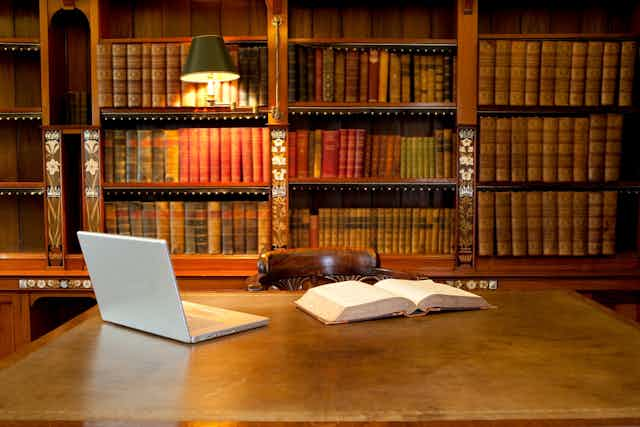
Friday essay: why libraries can and must change
Associate Professor in Media, University of Notre Dame Australia
Disclosure statement
Camilla Nelson does not work for, consult, own shares in or receive funding from any company or organisation that would benefit from this article, and has disclosed no relevant affiliations beyond their academic appointment.
The University of Notre Dame Australia provides funding as a member of The Conversation AU.
View all partners
There is a chapter towards the end of Stuart Kells’s The Library: A Catalogue of Wonders , in which the author envisions the library of the future as one in which “dreary hordes of students” stare mindlessly at “computers and reading machines”, ignorant of the more refined pleasures of paper and ink, vellum and leather.
This – the death of the book – is a familiar lament recounted by bibliophiles everywhere; a tragic epic in which the Goliath of technology slays the David of art and culture.
It may be superficially appealing to some. And yet, it misses the reality that writing itself is also a technology. Along with the wheel and the lever, it is one of the greatest technologies ever invented. The history of writing predates the invention of the book. It parallels and is a part of the history of other technological forms.
The history of the library is replete with mechanical marvels.
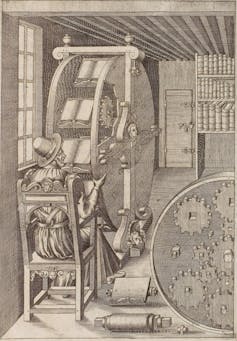
Take, for example, the book wheel , the scholar’s technology of the 16th century, an ingenious mechanical device operated by foot or hand controls, allowing a reader to move backwards and forwards across editions and volumes, referencing many different books as quickly possible.
Closer to our own century, there’s the Book Railways of the Boston Public Library installed in 1895, with tracks laid around every level of the stack to transport books. Or the ultra-modern teletype machine and conveyor belt used to convey book requests by the Free Library of Philadelphia in 1927. Or the current book retrieval system used at the University of Chicago, which boasts a system of robotic cranes .
Unlike Kells, I think there is a fabulous quality to the dream of an infinite library that can assemble itself in bits and bytes wherever a reader calls it into being. It sits well with the democratic dream of mass literacy.
It may well take an archaeologist – working a thousand years from now – a lifetime to unlock the data in our already defunct floppy discs and CD Roms. Then again, it took several hundred years of patient work before Jean-François Champollion deciphered Egyptian hieroglyphs in 1822, and even longer for Henry Rawlinson to unlock the secrets of the cuneiform scripts of ancient Mesopotamia.
Of course, Kells’s new book is not a history of reading or writing. It is a history of books as artefacts. It tells of books of doubtful or impeccable provenance, discovered in lost libraries or inaccessible private collections, purloined by book thieves, or crazed and nefarious book collectors, or at the behest of rich or royal patrons. It is a narrative – albeit with an unfortunate, cobbled together quality – brimming with strange anecdotes about a small handful of books owned by a small handful of people; lost books yielding strange surprises, from discarded condoms to misplaced dental appointment slips.
Kells’s favoured haunts are the chained libraries of medieval monks, and the bawdy or scandalous collections of wealthy 18th century patrons. The library of St Gall , for example, which houses one of the largest medieval collections in the world. Or the Bodleian at Oxford, which was never intended to be an inclusive collection, but rather, as its founder Thomas Bodley put it, sought to exclude “almanackes, plaies, and an infinit number” of other “unworthy matters” which he designated “baggage bookes” and “riff-raffe”.
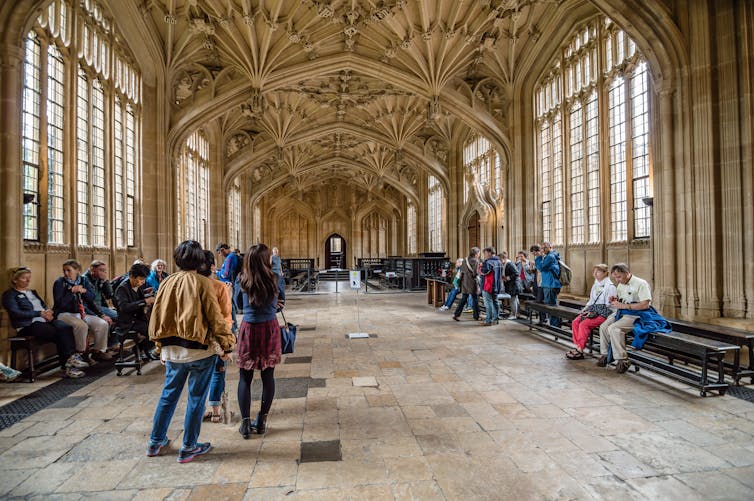
I am a great lover of books. I have been lucky enough to while away the hours in libraries from Beijing to St Petersburg, Belgrade and Buenos Aires. But in an age of economic disparity and privatised public services – of pay walls, firewalls and proprietary media platforms, not to mention Google and Amazon – it is difficult to feel convinced by this bibliophile’s nostalgic reveries.
Embodying an idea of society
More than 20 years ago, when I was living in New York, eking out a living as a copyeditor and more often as a waitress, I became a regular at the 42nd Street Library (also known as the New York Public Library), on Fifth Avenue between 40th and 42nd Streets, a few blocks from the apartment that I shared in Midtown.
It was not just the size of the collection that drew me in – the 120 kilometres of bookshelves housing one of the largest collections in the world – or the ornate ceilings of the main reading room, which ran the length of a city block, with 42 oak tables for 636 readers, the bookish dimness interrupted by the quiet glow of reading lamps. I was fascinated by the library’s pneumatic system .
This labyrinthine contraption, which had been state-of-the-art around the dawn of the 20th century, sent call slips flying up and around through brass tubes descending deep underground – down seven stories of steel-reinforced book stacks where the book was found, then sent up on an oval shaped conveyor belt to arrive in the reading room.
The pneumatic system – with its air of retro, steampunk or defunct book technology – seemed to intimate the dream of a future that had been discarded, or, at least, never actually arrived. Libraries are not just collections of books, but social, cultural and technological institutions. They house not only books but also the idea of a society.
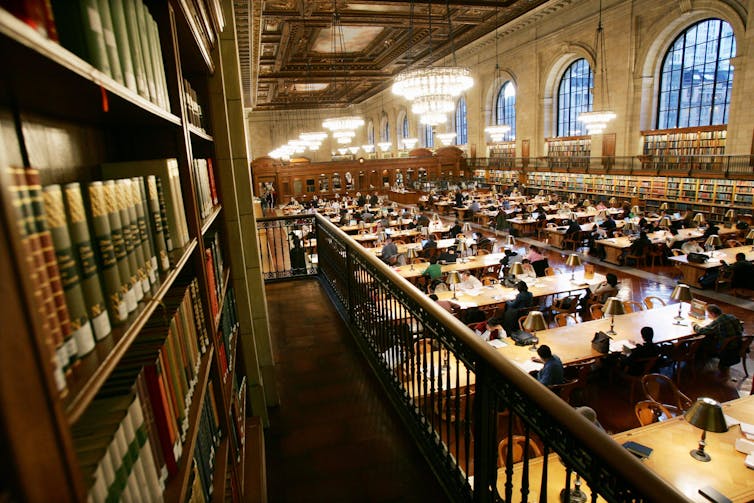
The predecessors of the New York Public Library, the Carnegie libraries of the 1880s, were not just book stacks but also community centres with public baths, bowling alleys, billiard rooms, and in at least one strange instance – at the Allegheny library in Pittsburgh – a rifle range in the basement.
Earlier in the 18th century, with the rise of industrial printing technologies and the spread of mass literacy, not only libraries but as many as a thousand book clubs sprang up through Europe. They were highly social, if occasionally rowdy places, offering a space not only for men but also women to gather. Monthly dinners were a common feature. Book club rules included penalties for drunkenness and swearing.
So too, the fabled Library of Alexandria – where Eratosthenes invented the discipline of geography and Archimedes calculated the accurate value of Pi – was not a collection of scrolls but a centre of innovation and learning. It was part of a larger museum with botanical gardens, laboratories, living quarters and lecture halls. Libraries are social places.
Lost libraries
Kells’s Catalogue of Wonders is at its best when it recounts the stories of these ancient libraries, charting the accidental trails of books, and therefore ideas, through processes of translating, pirating and appropriation. And the trades and technologies of papermaking that enabled them.
The library of the Pharaoh Ramses II in the second millennium BCE contained books of papyrus, palm leaves, bone, bark, ivory linen and stone. But “in other lands and other times,” Kells writes,
books would also be made from silk, gems, plastic, silicon, bamboo, hemp, rags, glass, grass, wood, wax, rubber, enamel, iron, copper, silver, gold, turtle shell, antlers, hair, rawhide and the intestines of elephants.

One sheep, he says, yields a single folio sheet. A bible requires 250. The Devil’s Bible , a large 13th-century manuscript from Bohemia, was made from the skin of 160 donkeys.
Ptolemy founded the Library of Alexandria around 300 BCE, on a spit of land between a lake and the man-made port of Pharos. He sent his agents far and wide with messages to kings and emperors, asking to borrow and copy books.
There are many stories about the dissolution of this library: that it was burnt by invading Roman soldiers or extremist Christians or a pagan revolt – or that a caliph ordered the books be burnt to heat the waters of the urban bathhouses. Or just as likely, as Kells points out, the scrolls, which were made of fragile papyrus, simply disintegrated.
But the knowledge contained in the scrolls never entirely disappeared. Even as the collection dissipated, a brisk trade in pirated scrolls copied out in a nearby merchant’s district ensured that the works eventually found their way to Greece and Constantinople, where other libraries would maintain them for another thousand years.
Destroyed collections
One thing that Kells fails to address in his book is the problems that arise when books are excluded, destroyed, censored and forgotten. And, indeed, when libraries are decimated.
Any list of destroyed libraries makes startling reading: The libraries of Constantinople sacked by the Crusaders, the Maya codices destroyed by Franciscan monks, the libraries of Beijing and Shanghai destroyed by occupying Japanese forces, the National Library of Serbia destroyed by the Nazi Luftwaffe, the Sikh Library of the Punjab destroyed at the behest of Indira Gandhi, the Library of Cambodia destroyed by the Khmer Rouge.
More recently, thousands of priceless manuscripts were burnt in the Timbuktu library in Mali and rare books spanning centuries of human learning were burnt at the University of Mosul. Yet more book burnings have been conducted by ISIS, in a reign of cultural devastation that includes museums, archaeological sites, shrines and mosques.
There is also destruction for which the so called “Coalition of the Willing” must accept responsibility. Dr Saad Eskander, the Director of the Iraq National Library and Archive, reported the devastation of the library in a diary posted on the British Library website: archival materials 60% lost, rare books 95% lost, manuscripts 25% lost.
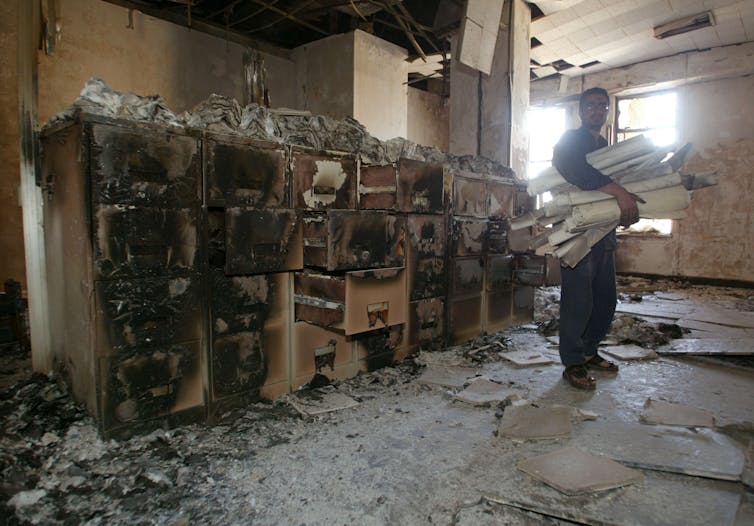
There may be something not quite right in mourning the death of books in a time of war, as people are dying. But the problem remains that without books and documents, the history of the world can be rewritten.
Indeed, as Iraqi librarians sought to preserve the bookish remains of their country in the still working freezer of a bombed out Iraqi officer’s club, the US military quietly airlifted the archives of the Baathist Secret Police out of the country.
These are the dark places where, as George Orwell once said, the clocks strike thirteen, and Kells does not go.
Of course, the great irony of censorship and book burning is that books are destroyed because it is believed that they are important, and they possess a certain power.
Libraries of the future
In the age of the globalisation of everything – and the privatisation of everything else – libraries can and must change. It is seldom discussed that one of the great destroyers of books are actually libraries themselves, bearing cost cuts, and space limitations. But this process can be ameliorated by companies such as Better World Books that divert library books from landfill, finding new owners and funding literacy initiatives – you can even choose a carbon neutral footprint at the checkout.
Libraries, by which I mean public libraries that are free, open and accessible, will not become extinct, even though they face new competition from the rise of private libraries and the Internet. Libraries will not turn into mausoleums and reliquaries, because they serve a civic function that extends well beyond the books they hold.
Libraries can and must change. Quiet study areas are being reduced, replaced not only by computer rooms but also by social areas that facilitate group discussions and convivial reading. There will be more books transferred to offsite storage, but there will also be more ingenious methods of getting these books back to readers.
There will be an emphasis on opening rare books collections to greater numbers of readers. There is and must be greater investment in digital collections. Your mobile phone will no longer be switched off in the library, but may well be the very thing that brings the library to you in your armchair.
The much heralded “death of the book” has nothing to do with the death of reading or writing. It is about a radical transformation in reading practices. New technologies are taking books and libraries to places that are, as yet, unimaginable. Where there will undoubtedly be new wonders to catalogue.
- Book reviews
- Public libraries
- Future libraries
- Friday essay

Compliance Lead

Lecturer / Senior Lecturer - Marketing

Assistant Editor - 1 year cadetship

Executive Dean, Faculty of Health

Lecturer/Senior Lecturer, Earth System Science (School of Science)
- News + Media
- Events + Calendar
- Food + Drink
- Local Guides
- Contest & Deals
- Membership & Donate
More from Volume One
- The Local Store
- Trolley Tours
- Volume One Tickets
- Chippewa Valley Family
- Events by Volume One
The Public Library
An essay by writer nickolas butler.
Nickolas Butler | March 8, 2019
Come inside here, stranger – the doors are open now. You’re safe. It is warm here, in this library. I want you think about that word – warm . I want you to hold it in the palms of your hand like a spark nested in the softest, driest tinder. It is warm here, and quiet. Words are air, sure. But they are warm air, exhaled from inside you. Welcome.
The sounds you hear are benevolent. Kind little sounds. The tip-tip-tapping of fingers on keypads. Everyone’s fingers touch those keypads. The beeping of books checked-in and checked-out – books in circulation, and movies, and music, too. This building is dry, friend, and here is a quiet corner for you to close your eyes. No one will bother you for a little while. Everyone at some point in their life has fallen asleep in the library. As a child, as a student, as a tired parent, as a retiree … this is a good place to fall asleep, because you are safe and unjudged.
Libraries are the best of America. Do you know that in most countries around the world, libraries are rarer than rubies? There are no small-town libraries even in oldest Europe. Libraries are an American promise, and through the library door a democracy shambles in; the poorest and the richest. Everyone’s library card looks the same. No one’s voice is louder than anyone else’s. No one’s money really matters; return your books on time, keep your promises, lend, borrow, share, pay your penalties, forgive those who can’t pay – every seven cycles there shall be a jubilee, a forgiveness.
No delusions – you never have to read Shakespeare here – but you can. You can file your taxes – or not. You can apply for a job – or simply work a crossword puzzle. You can listen to Dvorak or Miles Davis – or Megadeth or Metallica – just ease those earphones onto your head. The bathroom is clean – use it. Wash your hands, wash your face. Here is a mirror; part your hair, brush your teeth. You’ll feel better, I know you will.
Daylight is fading, and I don’t know where you’ll go from here. I am sorry about that. There should be libraries for night-owls, too. But librarians need their sleep. We say librarian – but what we really mean is – social worker, janitor, teacher, professor, psychologist, travel agent, security guard, and bibliophile .
How do you write about poverty? What can you say? You’re against it, sure. But then what? The library doesn’t try to cure poverty or homelessness. The library doesn’t even open its mouth to comment. As always, the library is mum, mute, non-partisan, discreet. The library just promises to be a safe place. Warm as I have said, and dry. The library doesn’t even promise a hello or a cup of coffee. But it is a place to go, a place to be, a place to rest, a place to sleep, a place to read. In the end, all it promises are books and for a little while. And yet, people find the library, like a refuge, a refuge, a refuge.
Nikolas Butler is the author of several novels, most recently Little Faith , which was published this month. Find it here .

Food Truck Friday
Downtown Eau Claire’s Monthly Mobile Food Party
2024 Summer Schedule »
Humming along since 2002, Volume One is a magazine, an event & video production company, & a retail store based in Eau Claire, WI.
(715) 552-0457
PUBLISHER / EDITOR / OWNER Nick Meyer
Subscribe to our Newsletters
How to Contribute
20 Years of Volume One
Volume One Services
Initiatives & advocacy, volume one events.
Staff • Contributors • Careers
Have questions? Email us: • editorial @ volumeone.org ( Editorial ,) • web @ volumeone.org ( Website ,) • localstore @ volumeone.org ( Store ,)
Terms of Use / Privacy Policy | ©2002-2024 Copyright Volume One Magazine
British Council
Why do we still need public libraries in the digital age, by tomas doherty, 19 september 2014 - 16:44.

Janko Ferlic, used under licence and adapted from the original .
After years of declining visitor numbers, libraries are experiencing a resurgence of interest and investment. The British Council's Tomas Doherty explains how libraries have adapted to new trends in how we read, work and socialise, as the British Council library in Dhaka reopens on 20 September.
Technology has changed the way we consume media
Libraries have always been at the heart of the communities they serve. They are accessible and safe spaces, providing access to huge resources of information and knowledge. There are an estimated 315,000 public libraries in the world, 73 per cent of them in developing and transitioning countries. The public library transcends national and cultural boundaries -- no matter where you are in the world, they are an essential part of creating and maintaining an educated and literate population.
But today, public libraries are at a turning point. The way we access and consume information has changed dramatically in the 21st century, and this presents major challenges and opportunities for public library systems across the world.
The advent of new technologies has changed some of our reading habits. But our need for shared, community-centred spaces to find information and connect with others is unlikely to change any time soon. To survive in the digital age and stay relevant, public libraries need to be brave and innovative. They must embrace both the physical and virtual.
Libraries must offer more than just books
Regular visitors to libraries expect them to continue to provide the services they have provided for many years. And rightly so -- the ‘traditional’ library of books, journals and quiet reading spaces shouldn’t just disappear. But libraries also need to respond quickly to real changes in how people live their lives.
In the UK, with heightened pressure on public expenditure and lowering visitor numbers, the traditional library system has come under more scrutiny. Why maintain expensive-to-run ‘physical’ libraries when growing numbers of people can already access the information they need from any location? As a result, in recent years public libraries have been threatened with closure across all parts of the country.
But there has also been a major rethink in the UK as to how exactly the library should be serving the public, and what the library of the future could and should look like. Last year, the Arts Council England published a wide-ranging and detailed piece of research, Envisioning the library of the future , aiming to answer these very questions. As well as emphasising the need for the physical and the digital to sit side by side, it finds that the 21st century public library service will be one in which “local people are more active and involved in its design and delivery.” A sense of community, always a defining feature of libraries, has renewed importance.
People in developing countries like Bangladesh need access to reliable information
In lower-income countries, like Bangladesh, the context for libraries is different but some of the same challenges remain. Bangladesh itself is a small country with a huge population, estimated at around 162 million people. There are high rates of poverty and illiteracy, especially in rural areas. According to the World Bank , 43 per cent of the total adult population is illiterate, with a disproportionate number female. Internet penetration in Bangladesh is only 22 per cent, 10 per cent less than the global average.
Bangladesh urgently needs greater access to reliable information for all its citizens. Not only do they need vital information about health, safety, nutrition and public services, but they also want opportunities to develop their literacy, learn skills for employability, and take part in collective educational and cultural activities. In Bangladesh, information is essential to survive and prosper - and lacking the right information can lead to worsening economic poverty.
With the right investment, libraries could be well-placed to provide some of that knowledge and those opportunities to communities all over Bangladesh. However, there’s also a need for library services to go beyond the ‘traditional’. An increasing digital divide (that has been shown to entrench both gender and class divisions), and ethnic and religious tensions continue unabated in some regions. Just like in the UK, Bangladesh has to rethink how libraries can better meet the needs of its people.
Bangladesh has plenty of libraries, but the quality of their services is inconsistent
Bangladesh's current library and information services provide access to information to varying degrees, but they are fragmented and unaligned in what they offer. For instance, there are 68 government public libraries, all in urban areas, which have long been in need of investment.
There many more non-governmental public libraries, around 1,000 spread across urban and rural areas. BRAC , the world’s largest NGO, maintains a network of 2650 Gonokendros (multi-purpose community learning centres), mostly located in rural villages. About 10 per cent of these have internet connectivity.
The Bangladesh Government’s Access to Information (a2i) programme has also set up a network of Union Information Service Centres (UISCs). These provide limited public internet access and operate in all 4,547 Union Parishads , the lowest tier of local government. Bangladesh's population is young, growing and ever-changing, so these services will have to find a way to adapt for the future.
Bangladesh's economy is improving fast
Bangladesh has gone through a period of unprecedented economic change over the last two decades, with growth averaging at around five to six per cent year-on-year. The country has been named by Goldman Sachs as one of its 'next 11' emerging economies . This speedy development is likely to continue, but for everyone to take part in it and gain equally, the country will need broad-based access to information. Libraries should be at the centre of this.
The British Council has a long history of running libraries in South Asia
Historically, the British Council’s international network of libraries played a vital role in educating a generation of leaders. In South Asia in particular, the libraries were, and continue to be, integral parts of the communities they serve. They provided access to a wide range of books and learning materials in the English language that were in limited supply elsewhere. In countries that were once isolated or had closed societies, like Burma, the British Council library was a venerated source of up-to-date information from the wider world.
In Bangladesh, people from all walks of life continue to speak with great respect and nostalgia about the role of the British Council library in their lives; the education it provided, the opportunities it created - many met their spouses there. The organisation first began to offer library services in Dhaka 60 years ago in 1954, in what was then known as East Pakistan. It later expanded to run branch libraries in the regional cities of Chittagong and Rajshahi. Today, there are British Council libraries in Dhaka and Chittagong, with more library services planned to open in Sylhet in early 2015.
Libraries have to modernise while staying true to the heart of what they offer
Like other library providers, the British Council has had to respond to lifestyle changes in the countries we work in. Our network of libraries has decreased in recent years, reflecting a global trend for fewer library visitors, with people more likely to read books and newspapers digitally, instead of on paper.
Our refurbished library in Dhaka will aim to bridge these two concepts, as it will be both a physical and a virtual space. As well as an updated physical collection of books, CDs and DVDs, the new library will provide users with remote access to over 80,000 e-books and 14,000 e-journals. The same quiet reading and study areas will be there for those who need it, but the library will be also be used as a cultural and social space where people can come together to watch theatre and film screenings, or take part in workshops, seminars, meetings, author talks and fashion events.
The concept of the library continues to hold a special place of importance in people’s hearts - and recent developments, like the reinvention of the Library of Birmingham in the UK (which has two million visitors a year, and lends its digital collections to ten million people a year), have shown how a library can still be a huge source of pride.
The British Council has carried out a Library Landscape Assessment of Bangladesh, a year-long research project that aims for a complete understanding of what people in Bangladesh want from libraries and information services. The assessment supports the case for more investment and involves Bangladeshi government ministries, BRAC , and the Bengal Foundation .
You might also be interested in:
- Is digital education easily accessible to Bangladeshi girls?
View the discussion thread.
Regions & Countries
- Publications
- Our Methods
- Short Reads
- Tools & Resources
Read Our Research On:
- Libraries 2016
- 1. Americans’ attitudes toward public libraries
Table of Contents
- 2. Library usage and engagement
- 3. A portrait of those who have never been to libraries
- Acknowledgments
- Methodology
Libraries have been in flux since the dawn of the digital age. They face changes in the materials they provide , in use of their services , in the composition of their patron populations , and in demands for new services . It is a set of disruptions as far-reaching and disorienting as the changes that are occurring in the news media as the nature of news is redefined and its distribution mechanisms are revolutionized .
Pew Research Center has been tracking these changes through surveys, especially in library usage patterns, since 2011 .
The 2016 survey shows that, within the context of evolving library usage patterns , public attitudes are largely positive about the library’s role in communities. Many Americans are interested in libraries offering a range of services – including those that help people improve their digital skills and learn how to determine what information is trustworthy. People think that libraries are a major contributor to their communities in providing a safe place to spend time, creating educational opportunities for people of all ages, and sparking creativity among young people.
Overall, a large majority of Americans age 16 and older (77%) think libraries provide them with the resources they need. This is especially true for young people: 84% of those between the ages of 16 and 29 say this.

Similarly, two-thirds (66%) say that if their local public libraries were closed it would have a major impact on their communities as a whole. On this question, there are several notable demographic differences. Among those most likely to say that a library closing would have a major impact on their communities: women (74%); those between the ages of 50 and 64 (73%); and college graduates (71%). Those least likely to report that a library closing would have any kind of impact on their communities: those without high school degrees (15% say a local library closing would have no impact on their communities); non-internet users (15%); and those in households earning less than $30,000 (10%).
Thinking about the impact of a library’s closing specifically on them and their families, the perceived impacts are more muted. Some 33% say that a library closing would have a major impact on them or their families, and this feeling is especially prominent among Latinos (48% believe that their libraries closing would have a major impact on their families); 50- to 64-year-olds (42%); those with annual household incomes of $30,000 or less (41%); and women (39%). Those least likely to report that a library closing would have any kind of impact on them and their families: men (37% say this would have no impact on them and their families); those ages 18 to 29 (39%); those without high school degrees (40%); and those without minor children (36%).
People generally say that libraries contribute, to some extent at least, to their communities in a variety of ways. Of particular note is the role libraries play in helping people decide what information they can trust. There was a large increase in people saying libraries help “a lot” in deciding what information they can trust from 2015, when the figure stood at 24%, to 2016, where it now stands at 37%.

Opportunity is also a notion that comes to people’s mind in thinking about libraries – whether that means a safe place to spend time, a place to pursue educational opportunity, or a place where creative juices flow. Those ages 16 and older were asked to consider how much their local public libraries contribute to their communities:
- 69% say their local libraries contribute “a lot” to providing a safe place for people to spend time.
- 58% think they contribute “a lot” toward creating educational opportunities for people of all ages.
- 49% believe they contribute “a lot” to sparking creativity among young people.
- 47% agree libraries contribute “a lot” to providing a trusted place for people to learn about new technologies.
- 38% say they contribute “a lot” to promoting a sense of community among different groups within their local areas.
- 37% believe they contribute “a lot” to helping people decide what information they can trust .
- 33% assert they contribute “a lot” to helping people when they seek health information .
- 29% believe they contribute “a lot” to serving as a gathering place for addressing challenges in their communities.
- 22% say they contribute “a lot” to helping people find jobs or pursue job training .
- 19% think they contribute “a lot” when natural disasters or major problems strike their communities.

Women are more likely than men to think that libraries make several of these contributions to their communities, including providing a safe place (74% of women say libraries help do this “a lot” vs. 65% of men), providing a trusted place for helping people learn about new technologies (52% vs. 42%) and helping people decide what information they can trust (41% vs. 32%). These gender differences might result from the fact that women are more likely than men to have used libraries in the past year.
When asked to think about how libraries might change to better serve the public, Americans have a pretty clear message: help people learn digital skills without neglecting traditional functions. Specifically:
- 80% of those ages 16 and older say libraries should “definitely” offer programs to teach people, including kids and senior citizens, how to use digital tools like computers and smartphones. This is a similar pattern captured in a 2015 survey.
- 57% think libraries should “definitely” have more comfortable spaces for reading and working. This is down slightly from the 64% who said this in 2015.
- 50% believe libraries should “definitely” buy 3-D printers and other digital tools to allow people to use them. This compares with 45% who said this in 2015.
- 24% say libraries should “definitely” move some print books and stacks out of public locations in order to free up more space for such things as tech centers, reading rooms and meeting rooms. This is a decrease from the 30% who said this in 2015.
Blacks and Hispanics are more likely than whites to say that libraries should definitely undertake several of these acts. For instance, 69% of blacks and 68% of Hispanics think libraries should provide more comfortable spaces for working and reading, while 51% of whites say that the same. Additionally, 69% of blacks and 63% of Hispanics say libraries should definitely buy 3-D printers and other high-tech tools, compared with 44% of whites. And 37% of blacks and 34% of Hispanics say libraries should definitely move books and stacks to provide other kinds of working spaces, while only 18% of whites think that.
Sign up for our weekly newsletter
Fresh data delivery Saturday mornings
Sign up for The Briefing
Weekly updates on the world of news & information
- Online Search
Half of Latinas Say Hispanic Women’s Situation Has Improved in the Past Decade and Expect More Gains
A quarter of u.s. teachers say ai tools do more harm than good in k-12 education, most americans think u.s. k-12 stem education isn’t above average, but test results paint a mixed picture, about 1 in 4 u.s. teachers say their school went into a gun-related lockdown in the last school year, about half of americans say public k-12 education is going in the wrong direction, most popular, report materials.
- March 7-April 4, 2016 – Libraries
1615 L St. NW, Suite 800 Washington, DC 20036 USA (+1) 202-419-4300 | Main (+1) 202-857-8562 | Fax (+1) 202-419-4372 | Media Inquiries
Research Topics
- Age & Generations
- Coronavirus (COVID-19)
- Economy & Work
- Family & Relationships
- Gender & LGBTQ
- Immigration & Migration
- International Affairs
- Internet & Technology
- Methodological Research
- News Habits & Media
- Non-U.S. Governments
- Other Topics
- Politics & Policy
- Race & Ethnicity
- Email Newsletters
ABOUT PEW RESEARCH CENTER Pew Research Center is a nonpartisan fact tank that informs the public about the issues, attitudes and trends shaping the world. It conducts public opinion polling, demographic research, media content analysis and other empirical social science research. Pew Research Center does not take policy positions. It is a subsidiary of The Pew Charitable Trusts .
Copyright 2024 Pew Research Center
- Newsletters
Site search
- Israel-Hamas war
- Home Planet
- 2024 election
- Supreme Court
- All explainers
- Future Perfect
Filed under:
Why public libraries are still essential in 2018
Libraries exist for the public. Amazon exists to maximize profits.
Share this story
- Share this on Facebook
- Share this on Twitter
- Share this on Reddit
- Share All sharing options
Share All sharing options for: Why public libraries are still essential in 2018
/cdn.vox-cdn.com/uploads/chorus_image/image/60477059/902931802.jpg.0.jpg)
This past weekend, Forbes published and then took down a controversial article. “This article was outside of this contributor’s specific area of expertise, and has since been removed,” said Forbes, after significant backlash . The article in question? An op-ed arguing that libraries are a waste of taxpayer money and should be replaced by Amazon stores.
Libraries do seem to be outside of author Panos Mourdoukoutas’s areas of expertise; he’s a professor who specializes in world economy. (A popular tweet suggested that Mourdoukoutas paid for the privilege to be published on Forbes, though it turned out to be an error ; he’s a paid blogger for Forbes.) But both the article itself and the backlash against it point to a profound anxiety centered on libraries and the question of whether they should be up for debate.
If we take it as read that public libraries exist and are good and important, then we’re saying that the services they provide are basic rights that it is our government’s responsibility to safeguard. If we suggest that libraries shouldn’t exist — that they’re a waste — then we call into question the rights that they protect.
Enter Mourdoukoutas’s now-deleted op-ed, whose central thrust was that the roles traditionally performed by libraries — lending books, of course, but also serving as community gathering places — are now performed better by “ third places ” like Starbucks and bookstore-cafes. And since Amazon’s brick-and-mortar bookstores are equipped with easy access to the comprehensive Amazon database of books around the world, the article concluded, Amazon bookstore-cafes are superior to libraries.
Many people might read this argument and protest, “But I must pay for books at Amazon! At a public library, I may borrow for free!” Mourdoukoutas had a comeback. “Let me clarify something,” he wrote on Twitter . “Local libraries aren’t free. Home owners must pay a local library tax. My bill is $495/year.”
It is true that libraries are partially funded by property tax dollars, in much the same way that taxpayers fund the other public services that we as a society have decided are vital to the public good, like schools and fire departments and parks and roadworks. I may not have children who attend school, but I still pay tax dollars toward the public school system, because we have agreed that when all children are educated, it’s good for the whole country.
https://t.co/B7KouDOxzB — Forbes (@Forbes) July 22, 2018
What Mourdoukoutas was trying to debate was not whether libraries are “a good buy” (by and large they are, especially if you don’t have lots of very valuable property to pay taxes on), but whether making library services available to the public is good for the whole country. He was putting into question the library’s status as a public good.
Libraries are designed to serve the public. Amazon is designed to maximize its profits.
Libraries are funded by the public in order to serve the public. They offer books, movies, and music curated to entertain and inform the public, with more available through interlibrary loan. They offer internet access and low-cost printing services. They offer financial literacy training and job search assistance. They serve non-English-speaking immigrants. They serve incarcerated people and homeless people and housebound people.
Libraries do all of this because we as a society have decided that we should put our tax dollars toward a resource that offers the public education and entertainment, and that sees serving our most vulnerable populations as part of its mission. We have decided that doing so is part of the public good.
An Amazon bookstore-cafe is funded by an enormous corporation for the purpose of maximizing its profits. It is stocked with books selected by algorithms, with most of its stock made up of recent best-sellers and books that Amazon has been successful at selling online, along with various Amazon electronic devices. Educating the public is not Amazon’s priority. It is not designed to serve vulnerable populations. There is no reason it would be designed with that purpose in mind: Amazon is a business, not a public utility, and its only goal is to make money.
Libraries aren’t perfect. That doesn’t mean they’re a waste of money.
In arguing that we should replace public libraries with Amazon bookstore-cafes, Mourdoukoutas was in effect arguing that offering resources to vulnerable populations is not a public good. He was arguing that poor people don’t deserve books or movies that will entertain them, that immigrants don’t deserve programs that will help them navigate bureaucracy in a foreign language, that unemployed people don’t deserve programs that can help them find and prepare themselves for jobs. He was arguing that providing these resources to the general public is not in our country’s best interest.
The public library stands in opposition to this argument. By virtue of its existence, it makes the case that free and easy access to information is important, that cultural enrichment is vital, and that the most underserved segments of our population deserve as much access to information and entertainment as anyone else.
That’s a utopian vision, and it’s not one that our library system in its current form always lives up to. Libraries are chronically underfunded, and President Trump has sought on multiple occasions to cut federal funding from the public library system altogether. The US is ranked 62nd in the world on the list of countries with the most libraries per capita , and the libraries we do have are not evenly distributed throughout the country, leading to library deserts . Moreover, because library funding is tied to property taxes, libraries that serve wealthy neighborhoods tend to have more resources than do libraries that serve poor neighborhoods.
But the solution to these problems is not to throw out libraries completely and replace them with mediocre bookstores designed to sell more Kindles. It is to recognize the vital work that libraries do in a functioning democracy, and grant them the funds they need to do that work properly.
Will you support Vox today?
We believe that everyone deserves to understand the world that they live in. That kind of knowledge helps create better citizens, neighbors, friends, parents, and stewards of this planet. Producing deeply researched, explanatory journalism takes resources. You can support this mission by making a financial gift to Vox today. Will you join us?
We accept credit card, Apple Pay, and Google Pay. You can also contribute via
Next Up In Culture
Sign up for the newsletter today, explained.
Understand the world with a daily explainer plus the most compelling stories of the day.
Thanks for signing up!
Check your inbox for a welcome email.
Oops. Something went wrong. Please enter a valid email and try again.

What young voters actually care about

Back to Black is the worst of bad musical biopics

Bridgerton’s third season is its best yet — but not because of romance

Why can’t prices just stay the same?

Biden’s surprise proposal to debate Trump early, explained


Psychedelics could treat some of the worst chronic pain in the world

The Public Library: A Photographic Essay
Robert dawson ( photographer ) , bill moyers ( foreword ) , ann patchett ( afterword ).
192 pages, Hardcover
First published April 1, 2014
About the author

Robert Dawson
Ratings & reviews.
What do you think? Rate this book Write a Review
Friends & Following
Community reviews.

So know this--if you love your library, use your library. Support libraries in your words and deeds. If you are fortunate enough to be able to buy your books, and you have your own computer with which to conduct research, and you're not in search of a story hour for your children, then don't forget about the members of your community who are like you but perhaps lack your resources--the ones who love to read, who long to learn, who need a place to go and sit and think. Make sure that in your good fortune you remember to support their quest for a better life. That's what a library promises us, after all: a better life. And that's what libraries have delivered.

Once, I was a snob who looks down on my local library because from my past experience, their collection consists of small local published books and mostly classics. After years of buying and hoarding books, my space for books became less and less (and my mom actually asked me to stop buying books), I tried to look for an alternative. Earlier this year, I tried browsing the library and to my surprise, their collections got bigger and better. With various activities for young patrons every week, either at the main library or at their branches. Looking at my young fellow library users, I'm thinking of donating a few of my books to the library. It's better than the books sitting on my shelf gathering dust. And now, I think I've become someone who has strong feelings of ownership towards the institution.

Join the discussion
Can't find what you're looking for.
- Search Menu
- Advance articles
- Author Guidelines
- Submission Site
- Open Access
- Why Submit?
- About Public Opinion Quarterly
- About the American Association for Public Opinion Research
- Editorial Board
- Advertising and Corporate Services
- Journals Career Network
- Self-Archiving Policy
- Dispatch Dates
- Journals on Oxford Academic
- Books on Oxford Academic

Article Contents
Anti-semitic attitudes of the mass public: estimates and explanations based on a survey of the moscow oblast.
- Article contents
- Figures & tables
- Supplementary Data
JAMES L. GIBSON, RAYMOND M. DUCH, ANTI-SEMITIC ATTITUDES OF THE MASS PUBLIC: ESTIMATES AND EXPLANATIONS BASED ON A SURVEY OF THE MOSCOW OBLAST, Public Opinion Quarterly , Volume 56, Issue 1, SPRING 1992, Pages 1–28, https://doi.org/10.1086/269293
- Permissions Icon Permissions
In this article we examine anti-Semitism as expressed by a sample of residents of the Moscow Oblast (Soviet Union). Based on a survey conducted in 1920, we begin by describing anti-Jewish prejudice and support for official discrimination against Jews. We discover a surprisingly low level of expressed anti-Semitism among these Soviet respondents and virtually no support for state policies that discriminate against Jews. At the same time, many of the conventional hypotheses predicting anti-Semitism are supported in the Soviet case. Anti-Semitism is concentrated among those with lower levels of education, those whose personal financial condition is deteriorating, and those who oppose further democratization of the Soviet Union. We do not take these findings as evidence that anti-Semitism is a trivial problem in the Soviet Union but, rather, suggest that efforts to combat anti-Jewish movements would likely receive considerable support from ordinary Soviet people.
Email alerts
Citing articles via.
- Recommend to your Library
Affiliations
- Online ISSN 1537-5331
- Copyright © 2024 American Association for Public Opinion Research
- About Oxford Academic
- Publish journals with us
- University press partners
- What we publish
- New features
- Open access
- Institutional account management
- Rights and permissions
- Get help with access
- Accessibility
- Advertising
- Media enquiries
- Oxford University Press
- Oxford Languages
- University of Oxford
Oxford University Press is a department of the University of Oxford. It furthers the University's objective of excellence in research, scholarship, and education by publishing worldwide
- Copyright © 2024 Oxford University Press
- Cookie settings
- Cookie policy
- Privacy policy
- Legal notice
This Feature Is Available To Subscribers Only
Sign In or Create an Account
This PDF is available to Subscribers Only
For full access to this pdf, sign in to an existing account, or purchase an annual subscription.
Student’s Essay Leads Her to Global Symposium in Switzerland

Batten graduating MPP student Khalila Karefa-Kargbo recently returned from the St. Gallen Symposium in Switzerland where she was one of only 100 students from around the world qualifying through its Global Essay Competition to participate as a Leader of Tomorrow .
Now in its 53rd iteration, the symposium is held annually at the University of St. Gallen in Switzerland, outside Zurich, as a forum for international and intergenerational dialogue on economic, political and social issues. The theme for this year’s symposium focused on scarcity. The essay competition in which Karefa-Kargbo competed asked participants to address the question: “Striving for more or thriving with less – What pressing scarcity do you see, and how do you suggest to tackle it?”
In a bit of a departure from traditional topics, Karefa-Kargbo focused on what she sees as a rising scarcity of “recognizing the inherent humanity that binds us together.”
“I had a few ideas about more tangible topics, but around January as I was reading the news and talking to people, this idea came to me and I felt like I could put something really cool together by going more abstract,” said Karefa-Kargbo this week after her return from overseas.

As to the experience of spending the week attending panels and taking part in one-on-one discussions with global leaders and fellow “leaders of tomorrow,” Karefa-Kargbo said her greatest takeaway is that one person really can make a big difference.
“Many people I met really trusted themselves to do scary and hard things, like moving to a strange country for school or starting their own business, even when they were not sure if it would pay off. It was incredible meeting others who were struggling, like me, to envision the future, but were confident it would all work out. It was great getting to know others like me and realizing that I can be the author of my own life.”
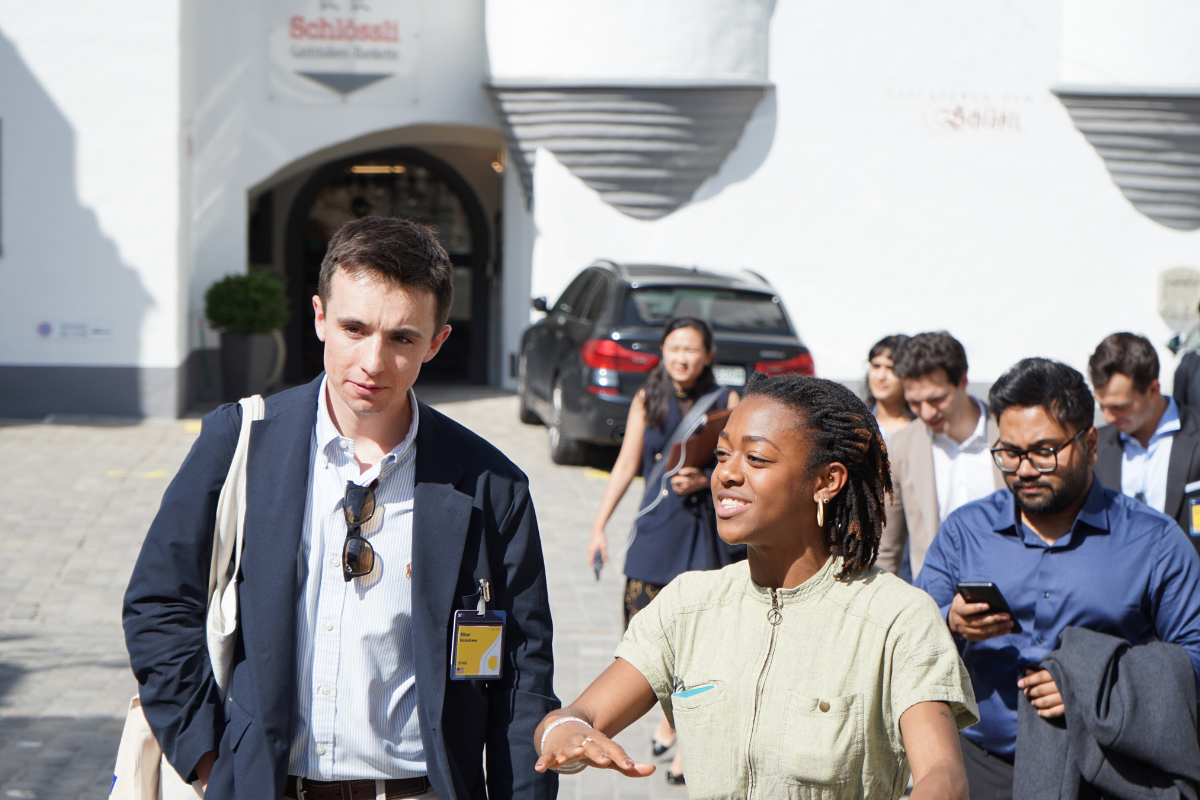
Two of Karefa-Kargbo’s favorite speakers from the week included former Malian presidential candidate Niankoro Yéah Samaké and Lindiwe Mazibuko, public leader, writer, academic fellow and CEO of Futurelect . She was also inspired by the symposium’s focus on intergenerational leadership and the valuable wisdom she gained through collectively looking at how the world currently looks and the vision of how it could look.
"I was struck by the fact that the total number of elected officials and parliamentarians in the whole world is only about 46,000. Of this number less than 30% are women and less than 3 percent are under 30. This showcases how our elected leaders don’t truly represent the world order, but also the capacity for change and the potential for representation to make a change."
After final exercises, Karefa-Kargbo is headed to Freetown, Sierra Leone, to spend time with family before returning to McLean, Virginia, to work for Capital One. For the long-term, she intends to stay connected with Leaders of Tomorrow.
Karefa-Kargbo’s essay can be viewed here .
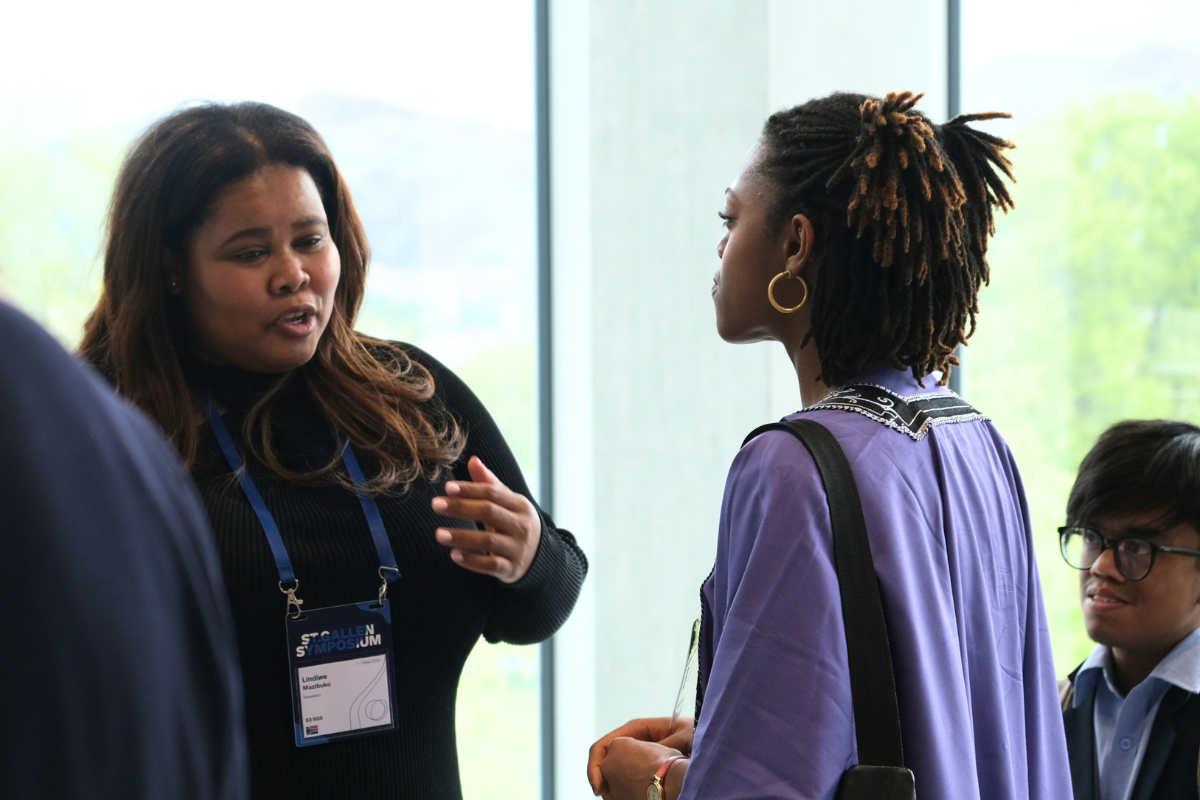
Stay Up To Date with the Latest Batten News and Events
- Today's news
- Reviews and deals
- Climate change
- 2024 election
- Fall allergies
- Health news
- Mental health
- Sexual health
- Family health
- So mini ways
- Unapologetically
- Buying guides
Entertainment
- How to Watch
- My watchlist
- Stock market
- Biden economy
- Personal finance
- Stocks: most active
- Stocks: gainers
- Stocks: losers
- Trending tickers
- World indices
- US Treasury bonds
- Top mutual funds
- Highest open interest
- Highest implied volatility
- Currency converter
- Basic materials
- Communication services
- Consumer cyclical
- Consumer defensive
- Financial services
- Industrials
- Real estate
- Mutual funds
- Credit cards
- Balance transfer cards
- Cash back cards
- Rewards cards
- Travel cards
- Online checking
- High-yield savings
- Money market
- Home equity loan
- Personal loans
- Student loans
- Options pit
- Fantasy football
- Pro Pick 'Em
- College Pick 'Em
- Fantasy baseball
- Fantasy hockey
- Fantasy basketball
- Download the app
- Daily fantasy
- Scores and schedules
- GameChannel
- World Baseball Classic
- Premier League
- CONCACAF League
- Champions League
- Motorsports
- Horse racing
- Newsletters
New on Yahoo
- Privacy Dashboard
Spokane prepares to build new affordable housing units with library access for both refugee and public
May 15—Spokane is one step closer to seeing $10 million in affordable housing units for refugees and the general public by 2025, without the use of tax dollars.
Thrive International, an organization that provides transitional housing to refugee and immigrant families, will develop 6980 N. Nevada St. with support from the Spokane Public Library.
The new 48-unit complex will be a combined effort to help relieve the affordable housing crisis as well as a global refugee crisis in Spokane, Thrive International Director Mark Finney told onlookers at a partnership launch Wednesday afternoon between Thrive and the Spokane Public Library. Mayor Lisa Brown also attended, declaring her support for the effort and the value of welcoming refugees into Spokane.
Spokane Public Library Executive Director Andrew Chanse said the library district bought the land from a bond in the 1990s to build a new library, but nothing came of it because of building issues with a sewer pipe that runs through the middle of the lot.
When Thrive came to the Spokane Public Library last year and asked for the land to build affordable housing, they exchanged the idea of community library resources built in on the same property.
That property plan includes a playground, a community garden, a greenhouse, a community center and a 24/7 library kiosk for books and library materials available outside of the main location.
Half of the apartments on the 1.64-acre lot will be reserved for refugees, while the other half will be open to the general public. Everyone in the Nevada neighborhood will be able to access the amenities.
Robert Foster, managing director of Courage Housing, is working with Thrive for the development of the project. He said they're paying for the maintenance, construction costs, upkeep and more expenses because the library supplied the land to Thrive for $10 a year spanning a period of 50 years.
Those costs will be offset by private, out-of-state investors with ties to Spokane, Foster said. He declined to name the investors on Wednesday without their permission.
"They're coming in with their capital that we are using as equity. And then the bank will be giving us a loan to complete the rest of that," Foster said.
Thrive's LLC will issue promissory notes to the investors, who will give Thrive a loan. Those investors will be getting a return, he said.
"At the end of 10 years, our goal is that Thrive, the nonprofit, is a 100% owner of the project and all of the private investors are out," Foster said. "Our investors are great people, but we don't want private, profit-seeking motives getting in the way of our service to the community."
Before the library offered the land to Thrive, it surveyed the community for support, Foster said. People were fond of the idea that amenities surrounding an apartment complex will be available to everyone, and the go-ahead was given to begin the development planning.
"It's not just for this complex. That's the vision," he said.
Staff at Thrive will also provide refugees at the complex with citizenship services and connect them to health care and vocational training, Foster said. It won't be full time because the community center is first and foremost for the library, but Thrive staff will use that center as a space for refugee needs.
Spokane Public Library already allows people to borrow public spaces online as long as they sign up. The spaces around town require an access code to get inside. The space at the new property will be the same concept, Chanse said.
It will not require any new library staff either, since library programmers and educators already offer their services at different locations around Spokane. It's just one more stop, Chanse said.
"Maybe they will do a story time here, or an educational program here about gardening. They are hypermobile with that," Chanse said. "We just want to be able to offer equal service around the community, and it's a nimble way for us to deliver it."
Voters approved a $77 million library bond in 2018. Chanse said the goal was to implement more 24/7 library kiosks, but there were no "takers" in that area.
In his opinion, this is the best way to open more access to library services while also helping those with housing needs.
"The integration of public library space in collaboration with this housing development, it's a really unique thing in this country for this to happen," Chanse said at the launch on Wednesday. "... We will be enriching the lives and strengthening our sense of community throughout Spokane."
The upcoming development marks Thrive's second venture into refugee housing in Spokane.
The Thrive Center, situated at the former Quality Inn, 10 E. Fourth Ave., offers transitional housing for refugee families. Nearly 95% of those are Ukrainian families displaced by the ongoing Russian conflict.
Recommended Stories
Netflix is becoming an ad-tech company.
Netflix has relied heavily on Microsoft for its ad-supported tier, but will now bring much of this work in-house.
Walmart shares pop after earnings beat, surpasses $500 billion in market cap
The retail giant posted strong numbers as Americans look to stretch their dollars.
Olivia Munn and John Mulaney froze embryos in hopes of having another baby after her breast cancer diagnosis. Here's how the process works during treatment.
"We just one more," says Olivia Munn, who has a 2-year-old son with her comedian partner, John Mulaney.
Samsung's Music Frame gets its first discount on Amazon
Samsung's new Music Frame speaker is is $25 off its sticker price on Amazon.
Colab's collaborative tools for engineers line up $21M in new funding
Engineers Adam Keating and Jeremy Andrews were tired of using spreadsheets and screenshots to collab with teammates — so they launched a startup, Colab, to build a better way. The two met as undergraduates at Memorial University of Newfoundland, where they studied mechanical engineering together. While they were completing their last internships prior to graduating (Andrews at Tesla, Keating at health startup Reflexion Medical), they noticed that professional engineering teams were relying on clunky tools — namely spreadsheets and Powerpoint decks — to get collaborative work done.
Poshmark’s ‘Promoted Closet’ tool lets sellers boost all their listings at once
Poshmark, the social commerce site that lets people buy and sell new and used items to each other, launched a paid marketing tool on Thursday, giving sellers the ability to promote their entire shop at once. Poshmark’s new feature, called “Promoted Closet,” uses machine learning to automatically promote individual product listings from a seller's entire inventory, identifying shoppers’ search terms and matching them with promoted items. Promoted Closet works like “cost per click” models on Etsy, Amazon, and Google Ads.
Intel's Thunderbolt Share makes it easier to move large files between PCs
Intel has launched a new software application called Thunderbolt Share that will make controlling two or more PCs a more seamless experience.
Sigma is building a suite of collaborative data analytics tools
In 2014, Jason Frantz and Rob Woollen co-founded Sigma Computing, a platform that overlays data stored in data platforms such as Snowflake and Google BigQuery with a spreadsheet-like interface for data visualization and analytics. With Sigma, the two former software engineers sought to tackle what they perceived as the intractable data challenges faced by large corporations: unwieldy tooling and difficult-to-manage data stores. "After recognizing the huge advances in cloud data infrastructure during the past decade, Jason and Rob identified a gap in the market," Sigma Computing CEO Mike Palmer told TechCrunch in an interview.
Spoor uses AI to save birds from wind turbines
Wind is the largest source of renewable energy in the U.S., according to the U.S. Energy Information Administration, but wind farms come with an environmental cost as wind turbines can wreak havoc on bird populations. Meet Spoor, the startup using AI to help wind farms mitigate that risk. Spoor is a software that uses machine learning to detect birds on video while also recording their movement and predicting their flight patterns.
The Morning After: In a bid to stop ban, TikTok creators are suing the US government
The biggest news stories this morning: Apple brings eye tracking to recent iPhones and iPads, Bandai is finally rereleasing a beloved Tamagotchi from 2004, Android 15 will make it harder for phone thieves to steal your data.
Cannabis and gaming payments startup Aeropay is now offering an alternative to Mastercard and Visa
The key to taking on legacy players in the financial technology industry may be to go where they have not gone before. The provider of pay-by-bank solutions for businesses started out helping cannabis retailers and gaming companies with their payments and is now entering into Visa and Mastercard’s territory by innovating the payment networks. Co-founder and CEO Dan Muller has a background as head of product for a company that built digital solutions for brands and retailers.
Mortgage rates today, May 16, 2024: Slowing inflation leads to lower mortgage rates
These are today's mortgage rates. Rates are gradually dropping, so it could be a good time to start actively house hunting. Lock in your rate today.
'Young Sheldon' is ending after 7 seasons. What to know as the series comes to a close.
“It felt like the right time to end it strong," the show's creator said.
2017-2020 Fiat 124 Spider: Future Classic
The Fiata closed up shop in 2020 after only four years. It wasn't hugely successful, but it's an interesting used car.
Biden's big inflation problem: Prices are now up nearly 20% since he took office
Inflation cooled slightly in April, but the seasonally-adjusted Consumer Price Index has now risen 19.4% in the three-plus years since Biden took office.
Temu accused of breaching EU's DSA in bundle of consumer complaints
Consumer protection groups around the European Union have filed coordinated complaints against Temu, accusing the Chinese-owned ultra low-cost e-commerce platform of a raft of breaches related to the bloc's Digital Services Act (DSA). Temu only launched in the region about a year ago but recently reported blasting past 75 million monthly users. For some reference, Temu's parent Pinduoduo reported revenues of nearly $35 billion for 2023, nearly double on the year prior; Temu was estimated to account for about 23% of that amount last year.
How to cancel your car insurance in 3 easy steps
Learn the rules for canceling your car insurance, including how to avoid a cancellation fee or get a refund on your policy premiums.
2024 NFL 'Sunday Night Football' schedule: Dates, matchups for all games this season
“Sunday Night Football” airs at 8:20 p.m. ET on NBC every week of the NFL regular season.
Chargers drop another creative schedule release video, with a dig at Harrison Butker's commencement address
The Chargers once again pulled no punches with their schedule release video.
Netflix ad tier reaches 40 million monthly active users
The announcement marked a big increase from the 5 million users the company disclosed one year ago.
Balboa Library and Fire Station No. 1 project moves forward to final design
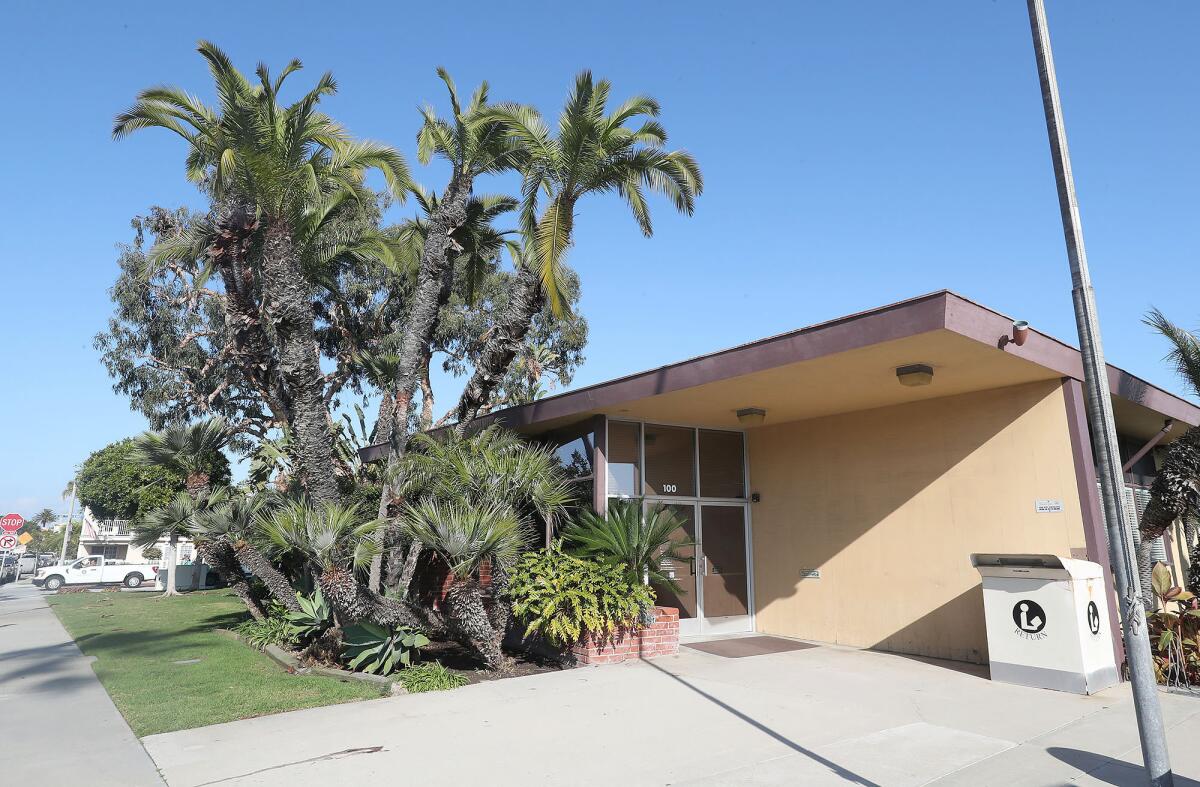
- Show more sharing options
- Copy Link URL Copied!
The Balboa Library and Fire Station No. 1 project will move ahead to its final design phase before it goes out to bid next summer, following a unanimous vote of the Newport Beach City Council on Tuesday.
Council members ultimately decided on the second of the three possible layouts for the project, which is currently estimated to carry a $16-million price tag. The proposed layout will bring the size of the building to about 9,170 square feet. The library will occupy 3,770 square feet, while 5,400 square feet will be used for the fire station.
An initial proposal for a public works storage facility was removed. Other additions include a playground and some additional green space. The new layout will orient the facility along Balboa Boulevard with public parking and the library entrance off of Bay Avenue.
Both facilities are in need of being updated, according to assistant city engineer Tom Sandefur, who delivered the staff presentation Tuesday night.
The Balboa Library was constructed in 1929 and was originally 566 square feet before it was expanded in 1952 and again in 1962 to encompass about 4,500 square feet, including 360 feet of museum space. Fire Station No. 1 was built in 1962 and is 3,431 square feet, according to the city.
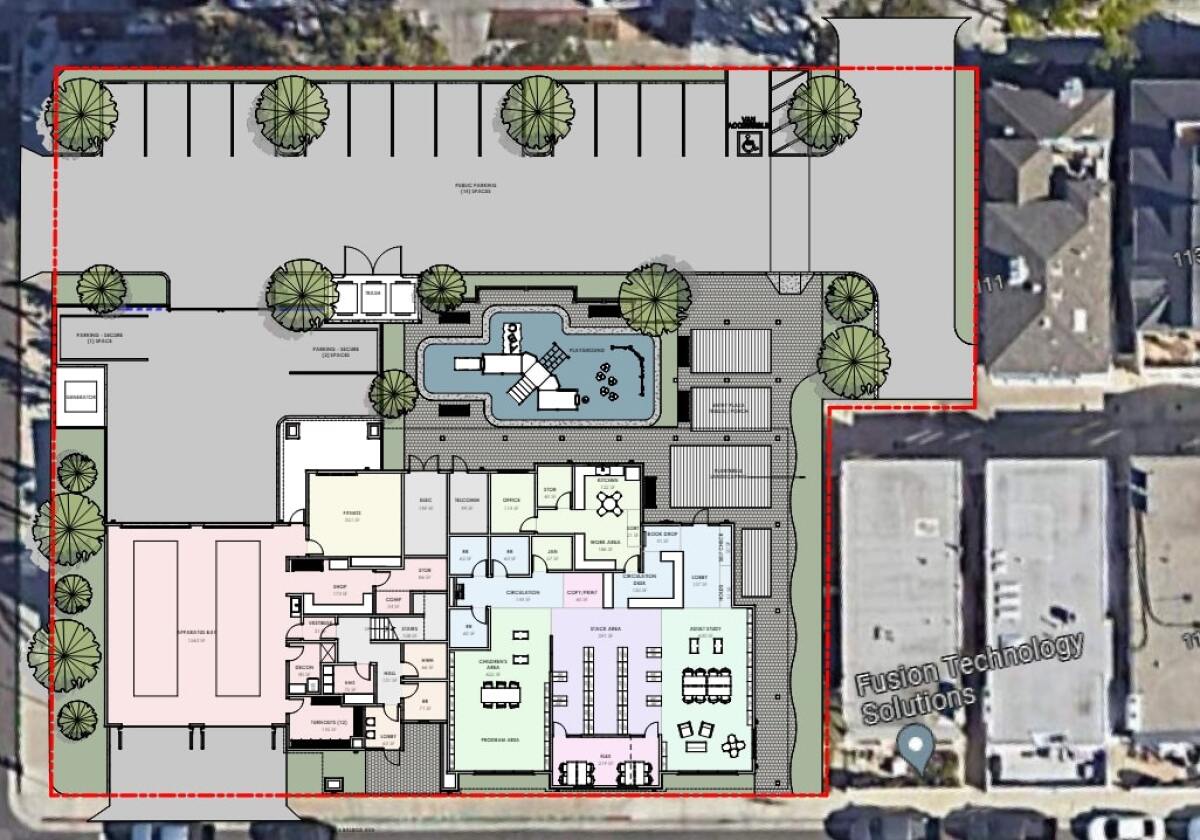
Sandefur said the Public Works Department coordinated with the library, fire department, city staff and the recreation and senior services department to develop plans for the 24,000-square-foot lot. Those plans were first reviewed by the Board of Library Trustees and the public in January, then by the Parks, Beaches & Recreation Commission in March.
Both favored the first layout, which includes the storage space, along with the “cottage house” theme for its exterior design.
The much-needed updates have been met with some concern from residents as the project would call for the removal of two existing landmark trees — a blue gum eucalyptus tree and a Canary Island date palm. City staff said removals are necessary as the eucalyptus tree is experiencing an internal fungal rot while the date palm faces removal because of “unavoidable” construction impacts.
City staff said the progression of the rot in the eucalyptus is at about 7% and that it would only take about five years before it would impact one-third of the tree — the threshold at which trees are typically recommended for removal.
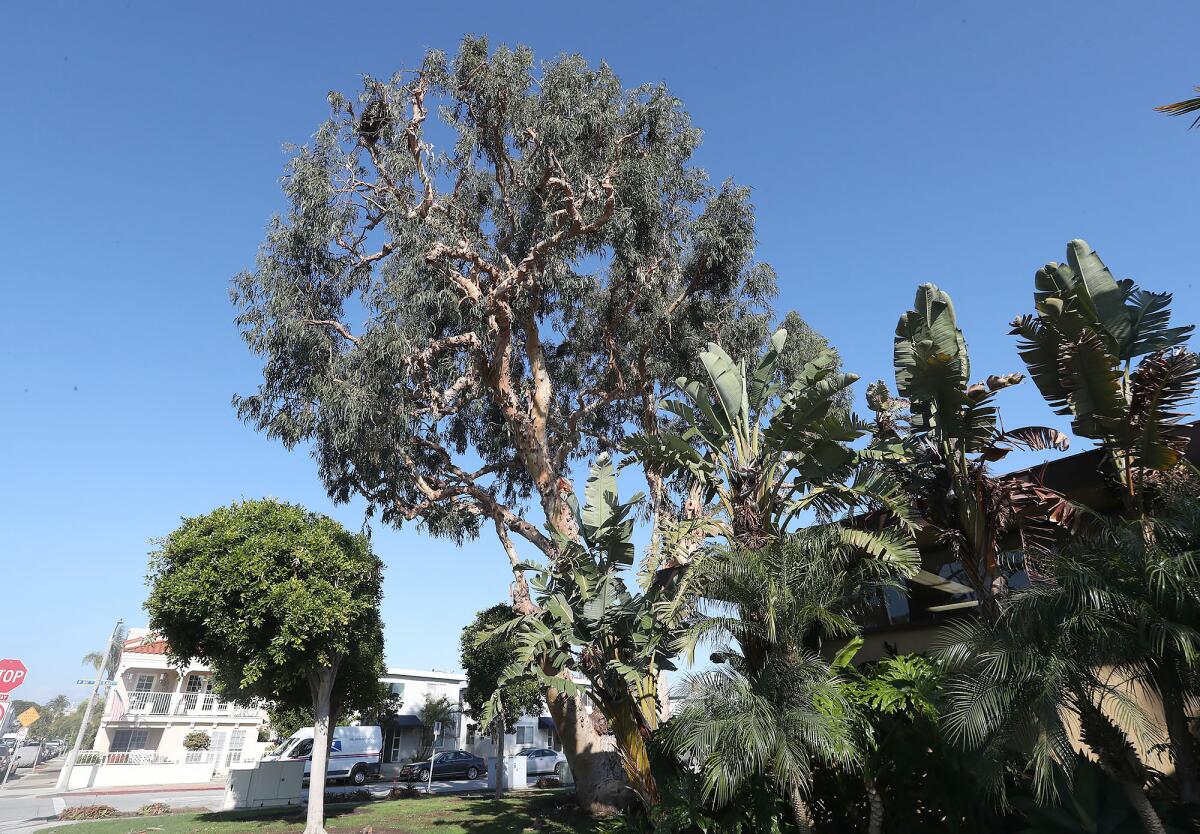
Members of the public raised objections in January after the first hearing on the project, saying they felt the city removes more trees than it plants and that the removal would impact what remaining habitat there is in Orange County for birds like the great blue herons that nest there. The city said it would not be removing the trees during nesting season, so no birds would be displaced.
Comments during public comment Tuesday reflected many of the same concerns. All of the speakers agreed that updates were necessary, but some residents said a few of the additions folded into the project were unnecessary, like the playground, equipment storage and additional parking.
“[The great blue herons] are our friends and neighbors, and your city staff says these birds are opportunistic. But I look on my rides, and I’ll see a hummingbird on a certain tree. And every time I go on that ride, that hummingbird is there. On the other hand on the south-side of the Back Bay trail, I notice the city or county took down a big tree that was a hawk’s home. Every time I go by there, no more hawk,” said resident and bird watcher Don Abrams.
“On Balboa Island, a neighbor pruned a tree down and a juvenile night heron, which had been living there for years, is now gone from the community,” he continued. “So, I’m not so much a tree lover — although that tree, I’ve gone over and looked at it, and it’s magnificent — but I’m a bird lover.

“These great blue herons, they’re not opportunistic. They’re not looking for a new place to live anymore than we would want to give up our homes.”
Mayor Will O’Neill said both buildings have been on the city’s capital improvement program for some time. He said he felt there wasn’t a question as to whether or not they would need to replace either facility.
“The question that we’ve been trying to work through as part of this design project has been what it would look like to do so,” O’Neill said.
O’Neill said Corona del Mar saw the completion of a library-fire station hybrid in 2019 and noted replacements, not rehabilitations, were necessary for both the Balboa Library and Fire Station No. 1. He also said the city has added about 680 trees to the Balboa Peninsula over the last two decades.
“When we’ve done the testing, and we’ve done it [through] an arborist that’s been trusted in the past and has done a great job for the city, it’s not enough to tell us that you can look at a tree and there’s not a problem, [that] ‘the arborist doesn’t know what he’s talking about.’ We don’t have that luxury to do that because, in the past, we have had limbs fall on people. We have had limbs fall on property.
“We have had major problems with trees like this ... we cannot allow for a failure. This is the point of why we do these tests in the first place, to make sure that we’re paying attention to the safety concerns as well as what we’re working through ... knowing that we have to do this work, it’s not feasible for us to be trying to design around a tree that is not going to work.”
All the latest on Orange County from Orange County.
Get our free TimesOC newsletter.
You may occasionally receive promotional content from the Daily Pilot.

Lilly Nguyen covers Newport Beach for the Daily Pilot. Before joining the Pilot, she worked for the Orange County Register as a freelance reporter and general assignment intern. She earned her bachelor’s in journalism at Cal State Long Beach. (714) 966-4623.
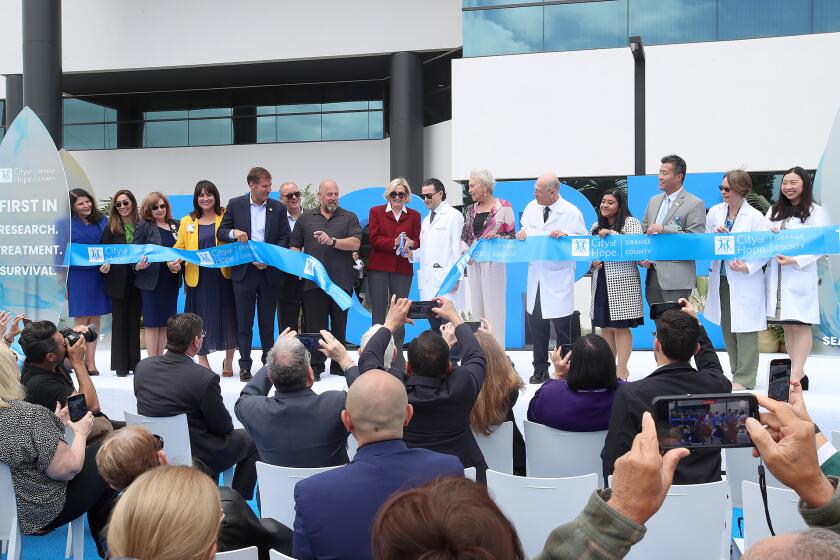
City of Hope expands with Seacliff facility in Huntington Beach
May 15, 2024
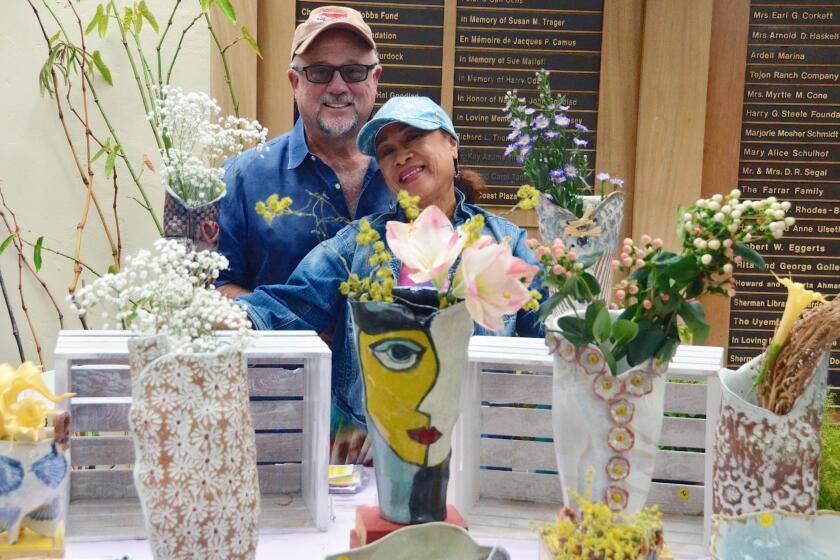
Nature and art merge for spring show in Corona del Mar

Man charged with helping to fraudulently acquire Laguna Beach home
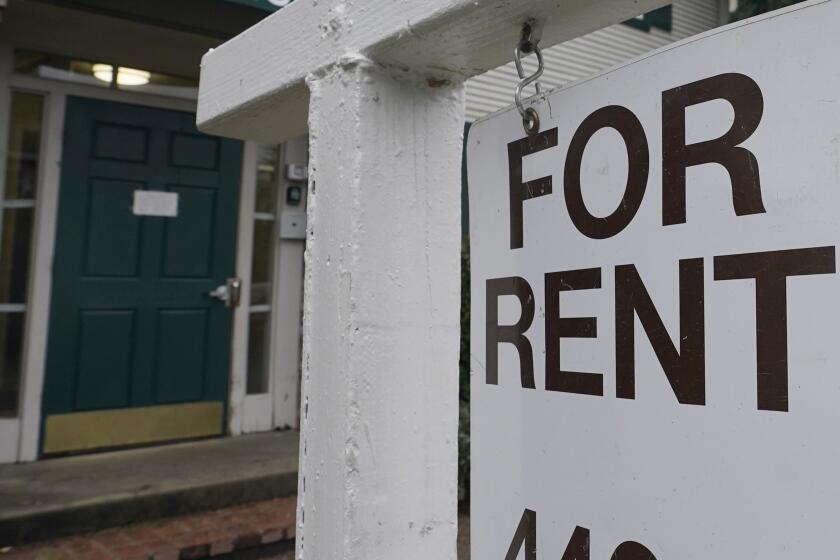
Costa Mesa law offering aid for no-fault evictions off to a slow but promising start
- Yekaterinburg
- Novosibirsk
- Vladivostok

- Tours to Russia
- Practicalities
- Russia in Lists
Rusmania • Deep into Russia
Out of the Centre
Savvino-storozhevsky monastery and museum.

Zvenigorod's most famous sight is the Savvino-Storozhevsky Monastery, which was founded in 1398 by the monk Savva from the Troitse-Sergieva Lavra, at the invitation and with the support of Prince Yury Dmitrievich of Zvenigorod. Savva was later canonised as St Sabbas (Savva) of Storozhev. The monastery late flourished under the reign of Tsar Alexis, who chose the monastery as his family church and often went on pilgrimage there and made lots of donations to it. Most of the monastery’s buildings date from this time. The monastery is heavily fortified with thick walls and six towers, the most impressive of which is the Krasny Tower which also serves as the eastern entrance. The monastery was closed in 1918 and only reopened in 1995. In 1998 Patriarch Alexius II took part in a service to return the relics of St Sabbas to the monastery. Today the monastery has the status of a stauropegic monastery, which is second in status to a lavra. In addition to being a working monastery, it also holds the Zvenigorod Historical, Architectural and Art Museum.
Belfry and Neighbouring Churches

Located near the main entrance is the monastery's belfry which is perhaps the calling card of the monastery due to its uniqueness. It was built in the 1650s and the St Sergius of Radonezh’s Church was opened on the middle tier in the mid-17th century, although it was originally dedicated to the Trinity. The belfry's 35-tonne Great Bladgovestny Bell fell in 1941 and was only restored and returned in 2003. Attached to the belfry is a large refectory and the Transfiguration Church, both of which were built on the orders of Tsar Alexis in the 1650s.

To the left of the belfry is another, smaller, refectory which is attached to the Trinity Gate-Church, which was also constructed in the 1650s on the orders of Tsar Alexis who made it his own family church. The church is elaborately decorated with colourful trims and underneath the archway is a beautiful 19th century fresco.
Nativity of Virgin Mary Cathedral

The Nativity of Virgin Mary Cathedral is the oldest building in the monastery and among the oldest buildings in the Moscow Region. It was built between 1404 and 1405 during the lifetime of St Sabbas and using the funds of Prince Yury of Zvenigorod. The white-stone cathedral is a standard four-pillar design with a single golden dome. After the death of St Sabbas he was interred in the cathedral and a new altar dedicated to him was added.

Under the reign of Tsar Alexis the cathedral was decorated with frescoes by Stepan Ryazanets, some of which remain today. Tsar Alexis also presented the cathedral with a five-tier iconostasis, the top row of icons have been preserved.
Tsaritsa's Chambers

The Nativity of Virgin Mary Cathedral is located between the Tsaritsa's Chambers of the left and the Palace of Tsar Alexis on the right. The Tsaritsa's Chambers were built in the mid-17th century for the wife of Tsar Alexey - Tsaritsa Maria Ilinichna Miloskavskaya. The design of the building is influenced by the ancient Russian architectural style. Is prettier than the Tsar's chambers opposite, being red in colour with elaborately decorated window frames and entrance.

At present the Tsaritsa's Chambers houses the Zvenigorod Historical, Architectural and Art Museum. Among its displays is an accurate recreation of the interior of a noble lady's chambers including furniture, decorations and a decorated tiled oven, and an exhibition on the history of Zvenigorod and the monastery.
Palace of Tsar Alexis

The Palace of Tsar Alexis was built in the 1650s and is now one of the best surviving examples of non-religious architecture of that era. It was built especially for Tsar Alexis who often visited the monastery on religious pilgrimages. Its most striking feature is its pretty row of nine chimney spouts which resemble towers.

Plan your next trip to Russia
Ready-to-book tours.
Your holiday in Russia starts here. Choose and book your tour to Russia.
REQUEST A CUSTOMISED TRIP
Looking for something unique? Create the trip of your dreams with the help of our experts.
HEPL board, which made headlines over teen book removal policy, hires new director

The Hamilton East Public Library board has hired a familiar face as its new library director.
Melissa Loiselle, who has been deputy director for seven months and previously worked for nine years in youth services at HEPL, will replace Edra Waterman, who resigned last December . Waterman lead the system as it was thrown into the national spotlight over the board's policy to move teen books deemed not "age appropriate."
The board of trustees unanimously approved Loiselle’s appointment in a vote Thursday. She served as director of the Vernon Township Public Library f rom January, 2021, until November 2023. Before that, Loiselle was youth services manager at HEPL’s Fishers Library.
Loiselle holds a master’s of library science from Indiana University.
“As a longtime resident of Fishers, it is an honor to serve my community once again,” Loiselle said in a HEPL news release. ”I will work hard to ensure the Library exceeds the expectations of the people of Fishers and Noblesville.”
More Hamilton County news: Carmel ordinance could pour cold water on short-term rentals for private pool parties
Waterman resigned after a tumultuous stint in which she sparred with HEPL’s ultra-conservative majority about a controversial book removal policy. The year-long relocation policy drew national attention after a novel by Indiana youth author John Green was moved from the teen section and he criticized the action on social media.
By the time Waterman resigned after 12 years at the helm, the conservatives had lost their majority on the board and the book removal policy had been rescinded.
Call IndyStar reporter John Tuohy at 317-444-6418. Email at [email protected] and follow on X/ Twitter and Facebook .

IMAGES
VIDEO
COMMENTS
This paper is aimed at describing an imaginary public library that will serve the needs of a middle-sized city with a population of 150,000 people. In particular, it is necessary to identify the major services that it will provide. Secondly, this essay will explain how this institution will cooperate with other public libraries and governmental ...
500 Words Essay on Library and Its Uses. A library is a place where books and sources of information are stored. They make it easier for people to get access to them for various purposes. ... A public library is open to everyone for fulfilling the need for information. They are run by the government, schools, colleges, and universities. The ...
The New Yorker writer Susan Orlean's most recent book, called simply The Library Book, begins with a personal love song to the subject before diving into the rich, troubled history of the Los Angeles Public Library and its iconic building in downtown L.A. In 2014, the photographer Robert Dawson published a book-length photographic essay that ...
In her bestseller about the Los Angeles Public Library fire of 1986, The Library Book (Citation 2018), Susan Orlean observed of homelessness, "Many librarians have told me that they consider this the defining question facing libraries right now" (73). This situation seems likely to become more challenging as safety nets for mental health ...
A public library is a library, most often a lending library, that is accessible by the general public and is usually funded from public sources, ... Harris, Michael H. (1967) "Library history: a critical essay on the in-print literature." Journal of Library History (1967): 117-125. in JSTOR, covers the main books for major countries; External ...
nity anchors, public libraries exist within nearly every U.S. community. For example, 17,219 library branches reach approxi-mately 96.4% of the population (Swan et al., 2014), and over 90% of Americans age 16 and older report visiting a public library at some point in their lives (Zickuhr, Rainie, & Purcell, 2013). There is also agreement
communities in and around the public library. Well-known is the work of David Lankes with his vision on a librarian as someone having the task "to improve society through facilitating knowledge creation in communities" (Lankes, 2011, p. 31). It has been cited many times in policy and strategy papers in the public library field and many ...
Entrance to the Central Library, Brooklyn, New York, 2009 Grand Canyon Community Library, Grand Canyon National Park, Arizona, 2012 Library, Death Valley National Park, California, 2009 This remote library in a trailer is the only library for hundreds of miles. The roof is shaded to lessen the intense summer heat of the hottest place on earth.
The main reading room of the New York Public Library. Mike Segar/Reuters. The predecessors of the New York Public Library, the Carnegie libraries of the 1880s, were not just book stacks but also ...
Libraries are the best of America. Do you know that in most countries around the world, libraries are rarer than rubies? There are no small-town libraries even in oldest Europe. Libraries are an American promise, and through the library door a democracy shambles in; the poorest and the richest. Everyone's library card looks the same.
The advent of new technologies has changed some of our reading habits. But our need for shared, community-centred spaces to find information and connect with others is unlikely to change any time soon. To survive in the digital age and stay relevant, public libraries need to be brave and innovative. They must embrace both the physical and virtual.
The Public Library. : A gorgeous visual celebration of America's public libraries including 150 photos, plus essays by Bill Moyers, Ann Patchett, Anne Lamott, Amy Tan, Barbara Kingsolver, and many more. Many of us have vivid recollections of childhood visits to a public library: the unmistakable musty scent, the excitement of checking out a ...
Pew Research Center has been tracking these changes through surveys, especially in library usage patterns, since 2011. The 2016 survey shows that, within the context of evolving library usage patterns, public attitudes are largely positive about the library's role in communities. Many Americans are interested in libraries offering a range of ...
The Public Library presents an inspiring selection of his work—libraries grand and modest, from the reading room at the New York Public Library to Allensworth, California's one-room Tulare County Free Library, built by former slaves. Essays, letters, and poetry by distinguished writers and librarians complete this impassioned
Access the most sought-after list of precisely written and well-researched essays, papers, and book reports. With IPL's gargantuan trove of essay samples and topics for reference, you're sure to come up with a coherent, detailed, and nuanced piece for college. Whether it's pressing issues plaguing college sports or intriguing and complex ...
He was putting into question the library's status as a public good. Libraries are designed to serve the public. Amazon is designed to maximize its profits. Libraries are funded by the public in ...
Pepper (2012) offer an historical perspective on public library architecture, calling it a "successful exercise in 'social engineering'—which can be defined as a collection of techniques designed to control, change, or manipulate people's attitudes, actions, or social behavior" (p. 446). ...
Internet Public Library. The Virtual library ( IPL, ipl2) was a non-profit, largely student-run website managed by a consortium, headed by Drexel University. Visitors could ask reference questions, and volunteer librarians and graduate students in library and information science formed collections and answered questions.
The Public Library presents a wide selection of Dawson's photographs— from the majestic reading room at the New York Public Library to Allensworth, California's one-room Tulare County Free Library built by former slaves. Accompanying Dawson's revealing photographs are essays, letters, and poetry by some of America's most celebrated writers.
Abstract. In this article we examine anti-Semitism as expressed by a sample of residents of the Moscow Oblast (Soviet Union). Based on a survey conducted in 192
From Poetry Off the Shelf March 2024. Monica Rico on cooking, grunt work, and the heat at General Motors. Submit poetry and letters to the editors of Poetry magazine. Poems, readings, poetry news and the entire 110-year archive of POETRY magazine.
Batten graduating MPP student Khalila Karefa-Kargbo recently returned from the St. Gallen Symposium in Switzerland where she was one of only 100 students from around the world qualifying through its Global Essay Competition to participate as a Leader of Tomorrow. Now in its 53rd iteration, the symposium is held annually at the University of St. Gallen in Switzerland, outside Zurich, as a forum ...
May 15—Spokane is one step closer to seeing $10 million in affordable housing units for refugees and the general public by 2025, without the use of tax dollars. Thrive International, an ...
Papers and Addresses of Franklin D. Roosevelt 67-69 (19 3 8). Jump to essay-7 Perry argued that devaluation resulted in an approximately 41 percent reduction in the value of the gold dollar from its 1918 worth, and thus a corresponding decrease in the value of his bond if the gold clause was not honored. See Perry, 294 U.S. at 3 55.
Footnotes Jump to essay-1 Gladstone, Realtors v. Village of Bellwood, 441 U.S. 91, 99-100 (1979). Jump to essay-2 This section discusses only the prudential standing doctrine. However, it is important to note that other prudential doctrines that have a basis in Article III of the Constitution may be relevant to the question of whether a federal court may exercise jurisdiction over a litigant ...
Sandefur said the Public Works Department coordinated with the library, fire department, city staff and the recreation and senior services department to develop plans for the 24,000-square-foot lot.
Zvenigorod's most famous sight is the Savvino-Storozhevsky Monastery, which was founded in 1398 by the monk Savva from the Troitse-Sergieva Lavra, at the invitation and with the support of Prince Yury Dmitrievich of Zvenigorod. Savva was later canonised as St Sabbas (Savva) of Storozhev. The monastery late flourished under the reign of Tsar ...
0:44. The Hamilton East Public Library board has hired a familiar face as its new library director. Melissa Loiselle, who has been deputy director for seven months and previously worked for nine ...
In City of Grants Pass v. Johnson, the Supreme Court is asked to address the applicability of the Eighth Amendment's bar on cruel and unusual punishments 1 Footnote U.S. Const. amend. VIII (cruel and unusual punishments [shall not be] inflicted). to city ordinances that impose fines, bans from public property, or prosecutions for criminal trespass on individuals who camp in public parks.
Currently, the only sub-national SPM estimates available using 1 year of survey data are at the Public Use Microdata Area (PUMA) level and at the state level using 1-year ACS data. In this paper, county-level SPM estimates are produced from PUMA-level estimates using a county to PUMA crosswalk from the Missouri Census Data Center.